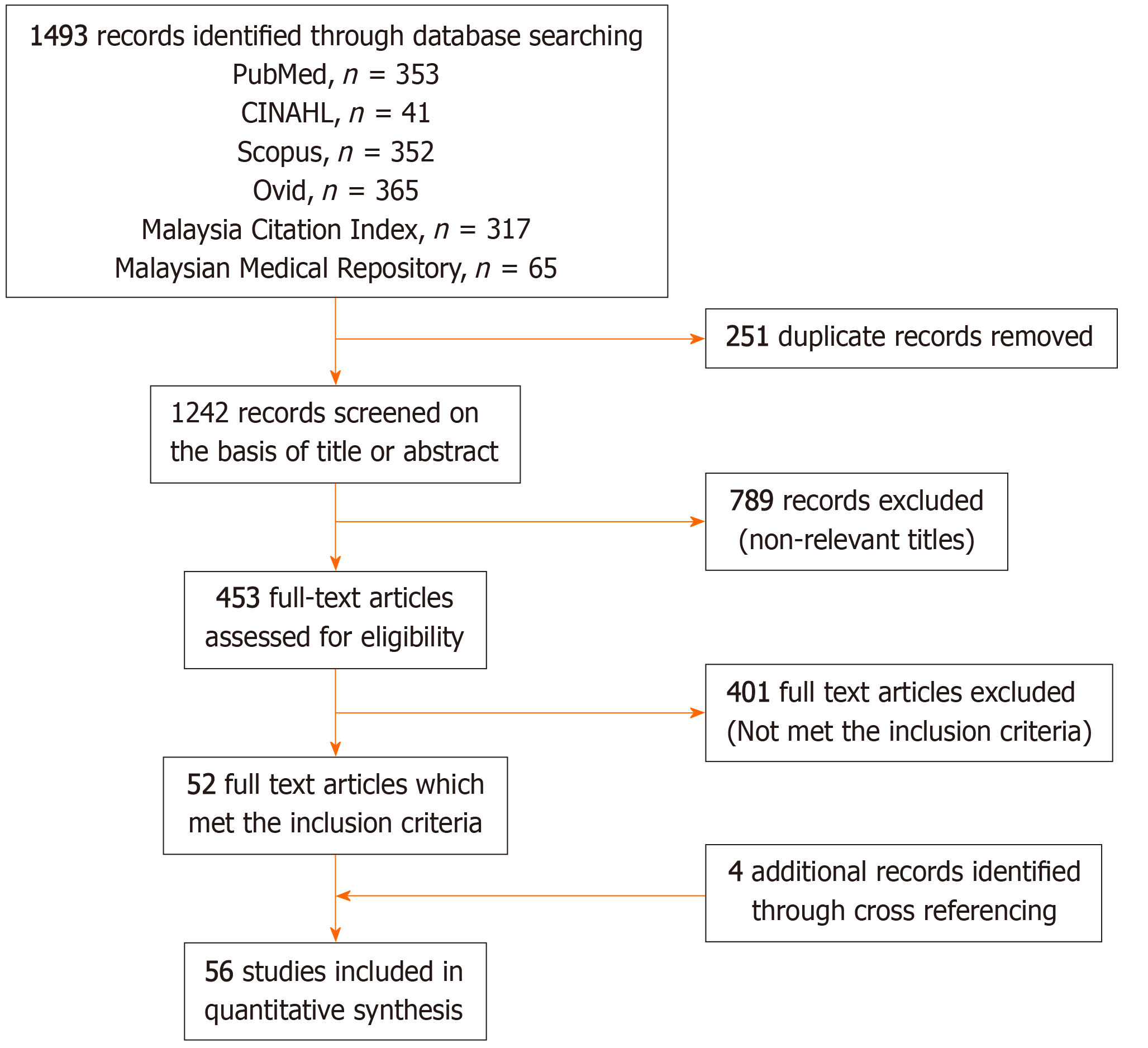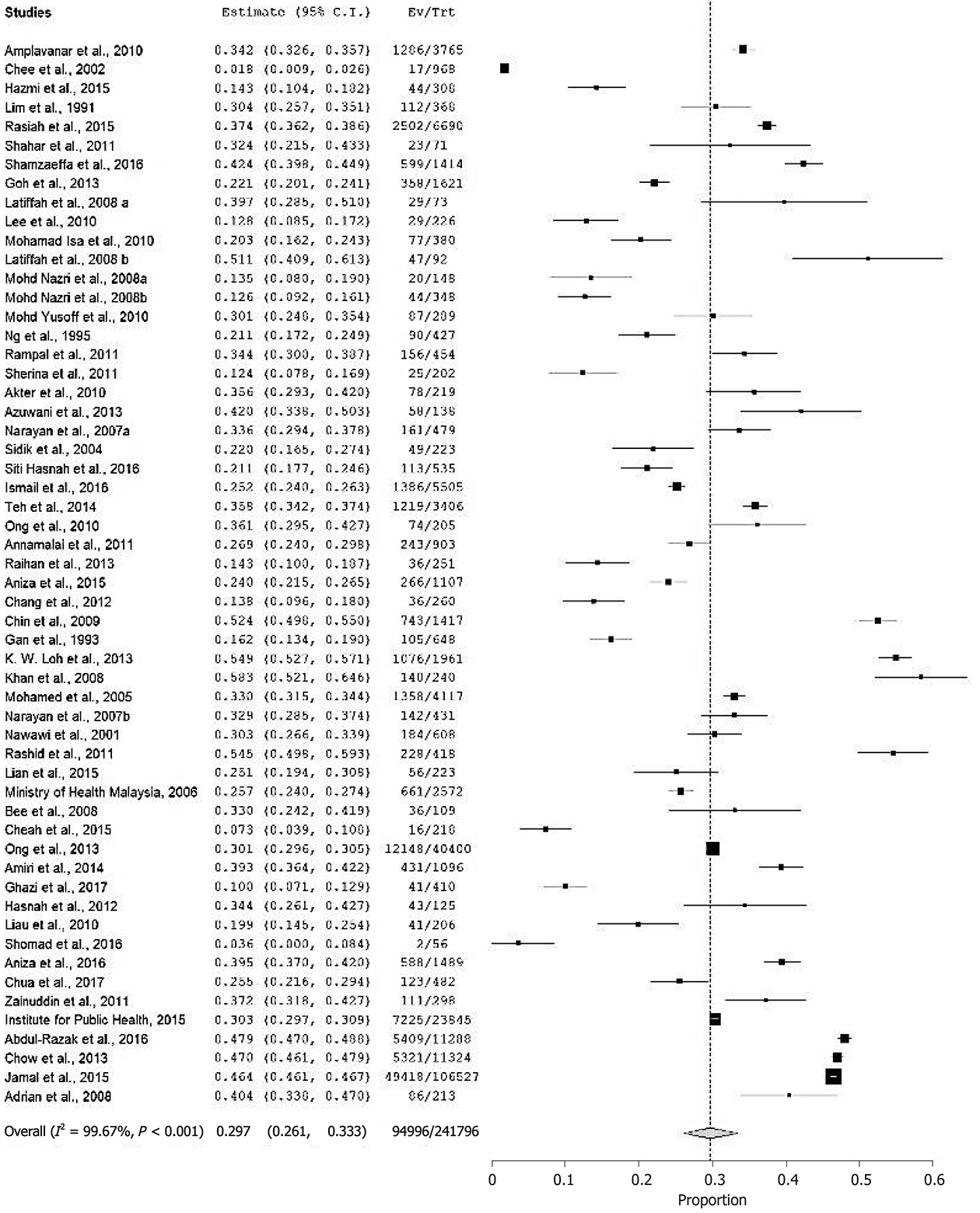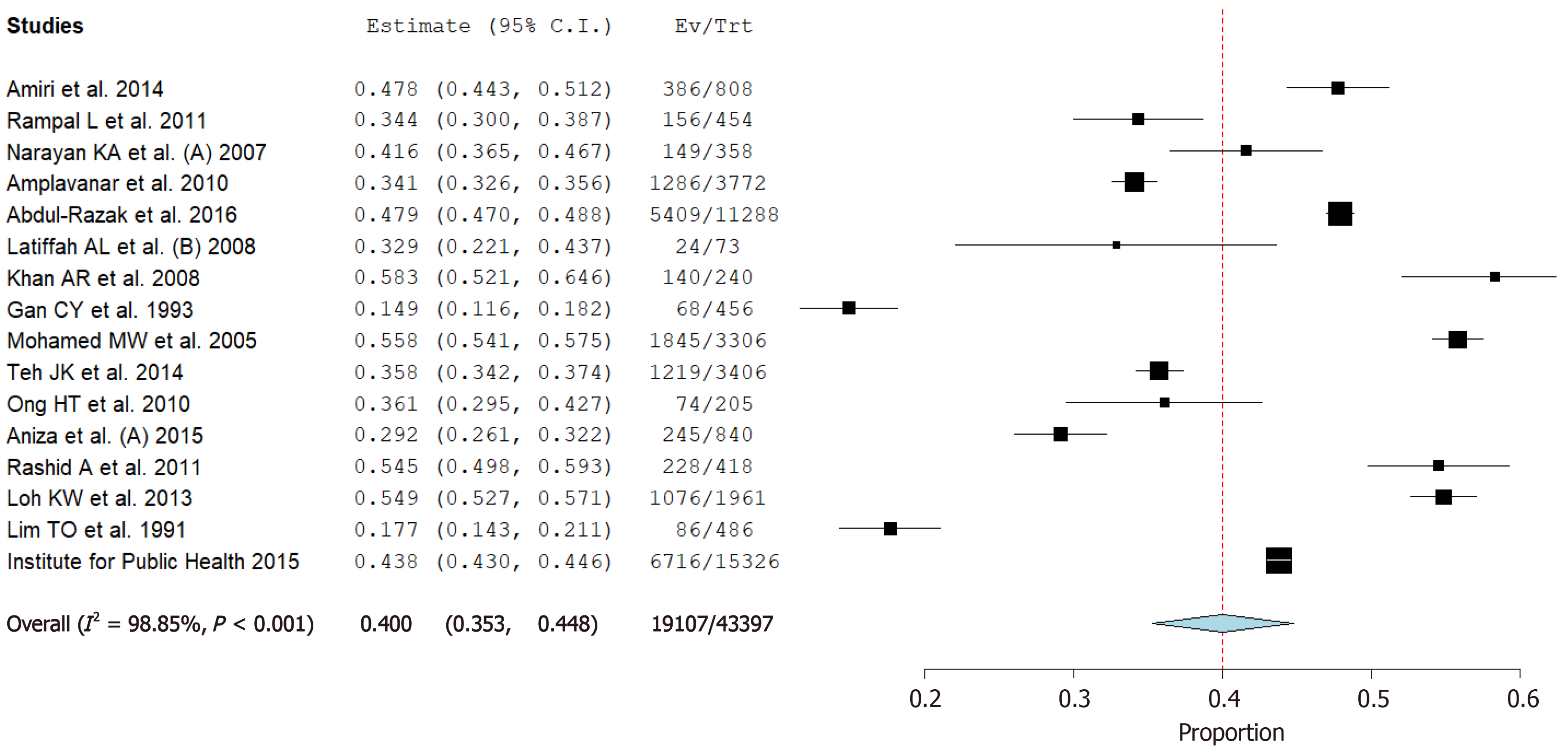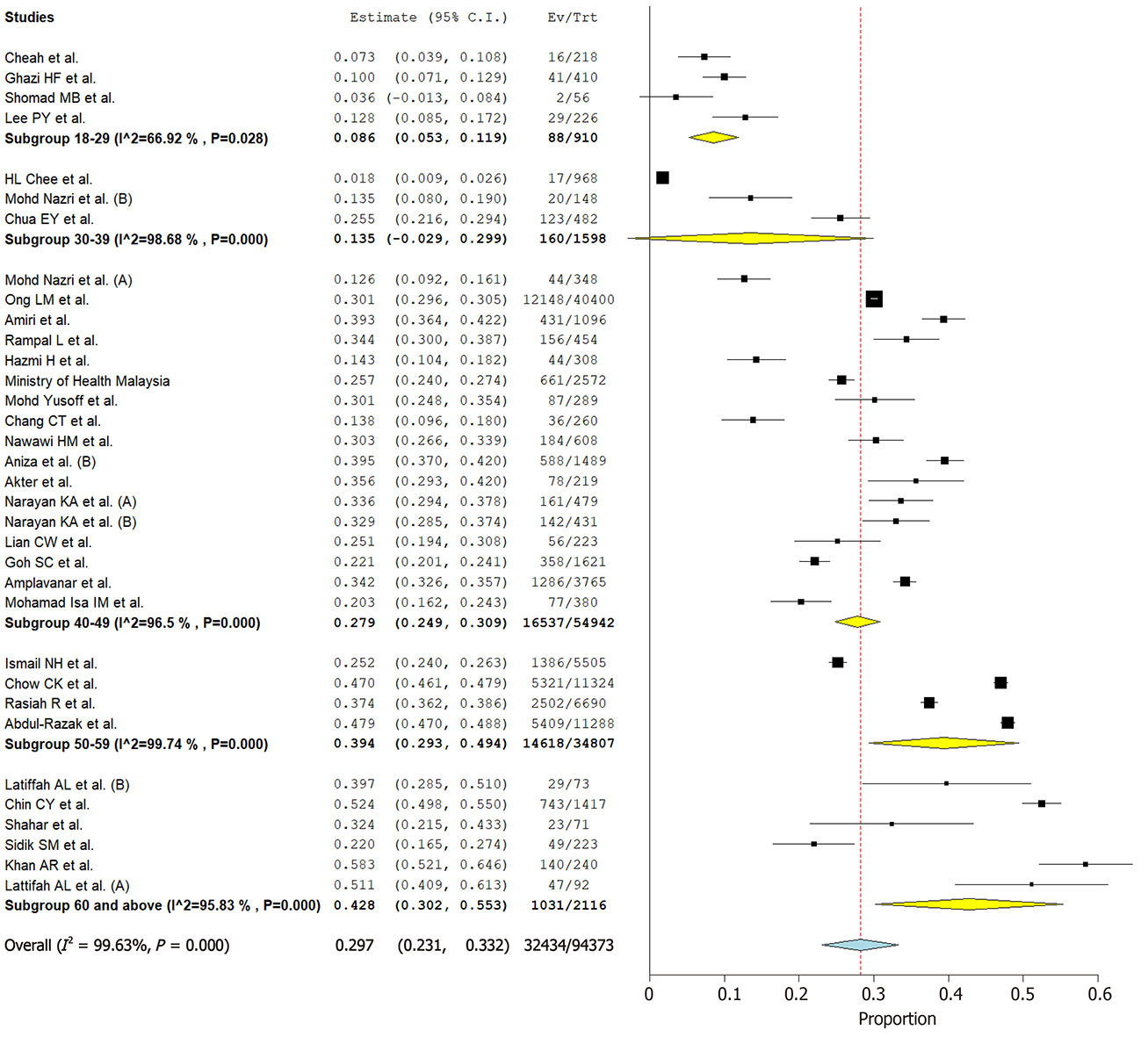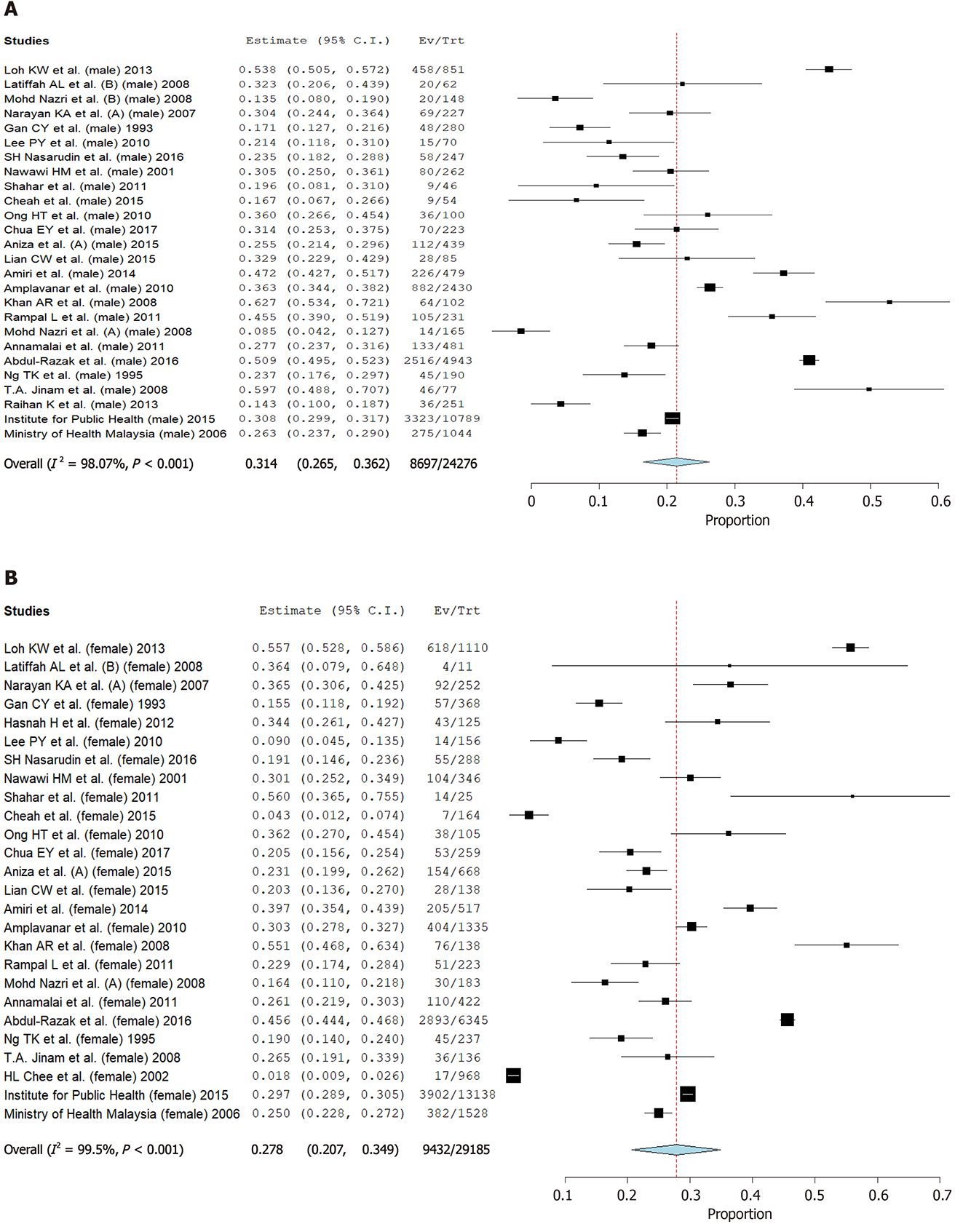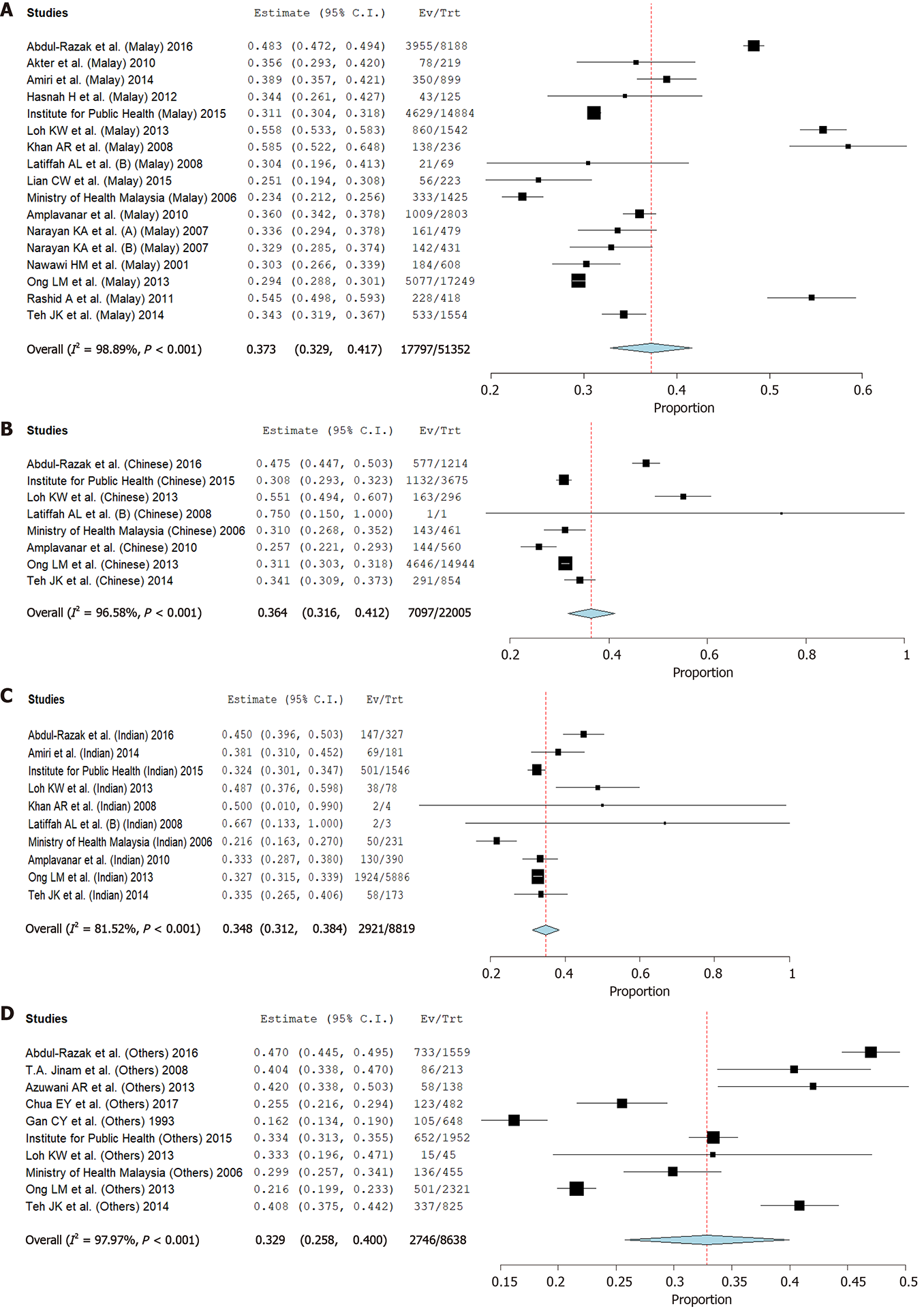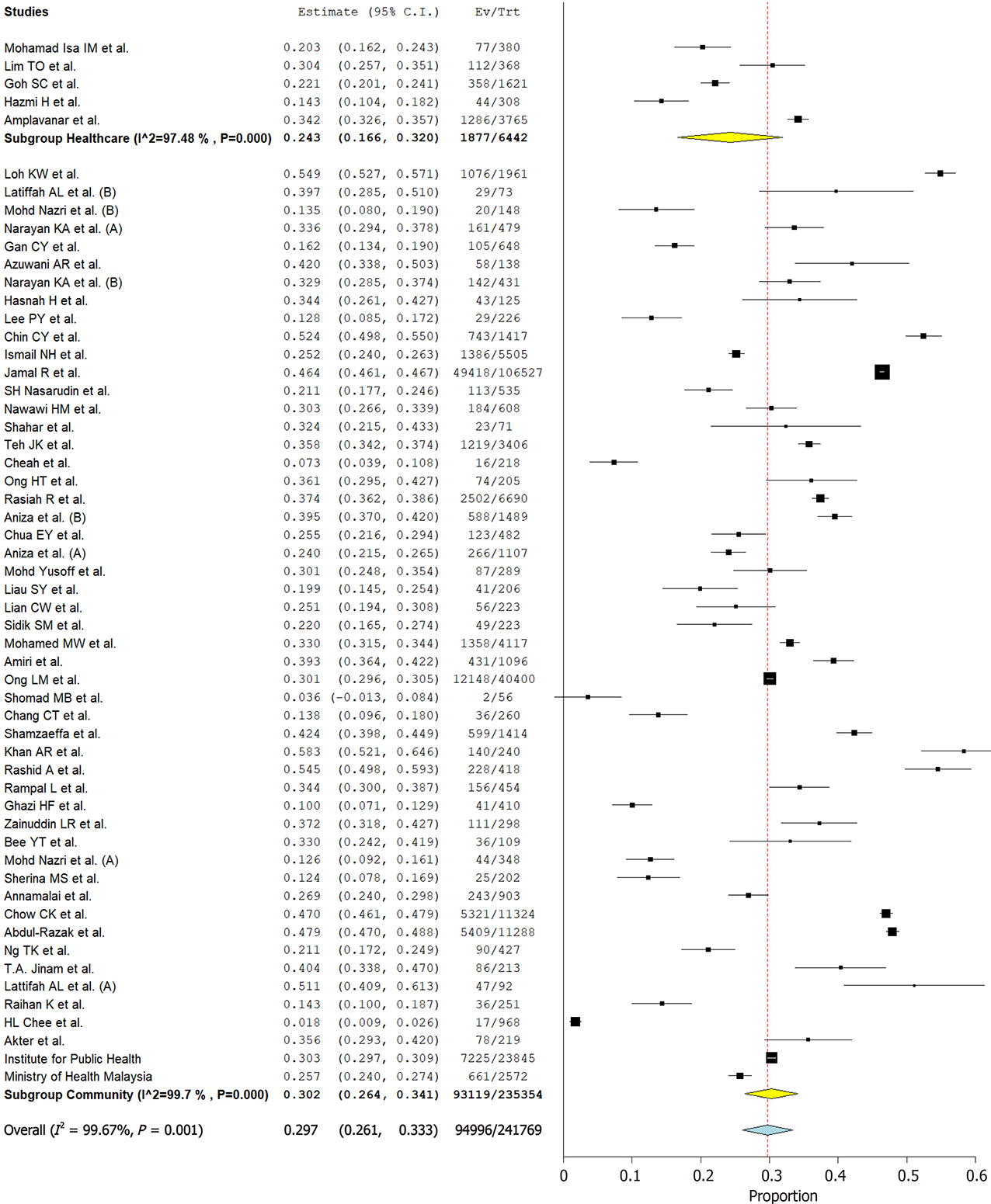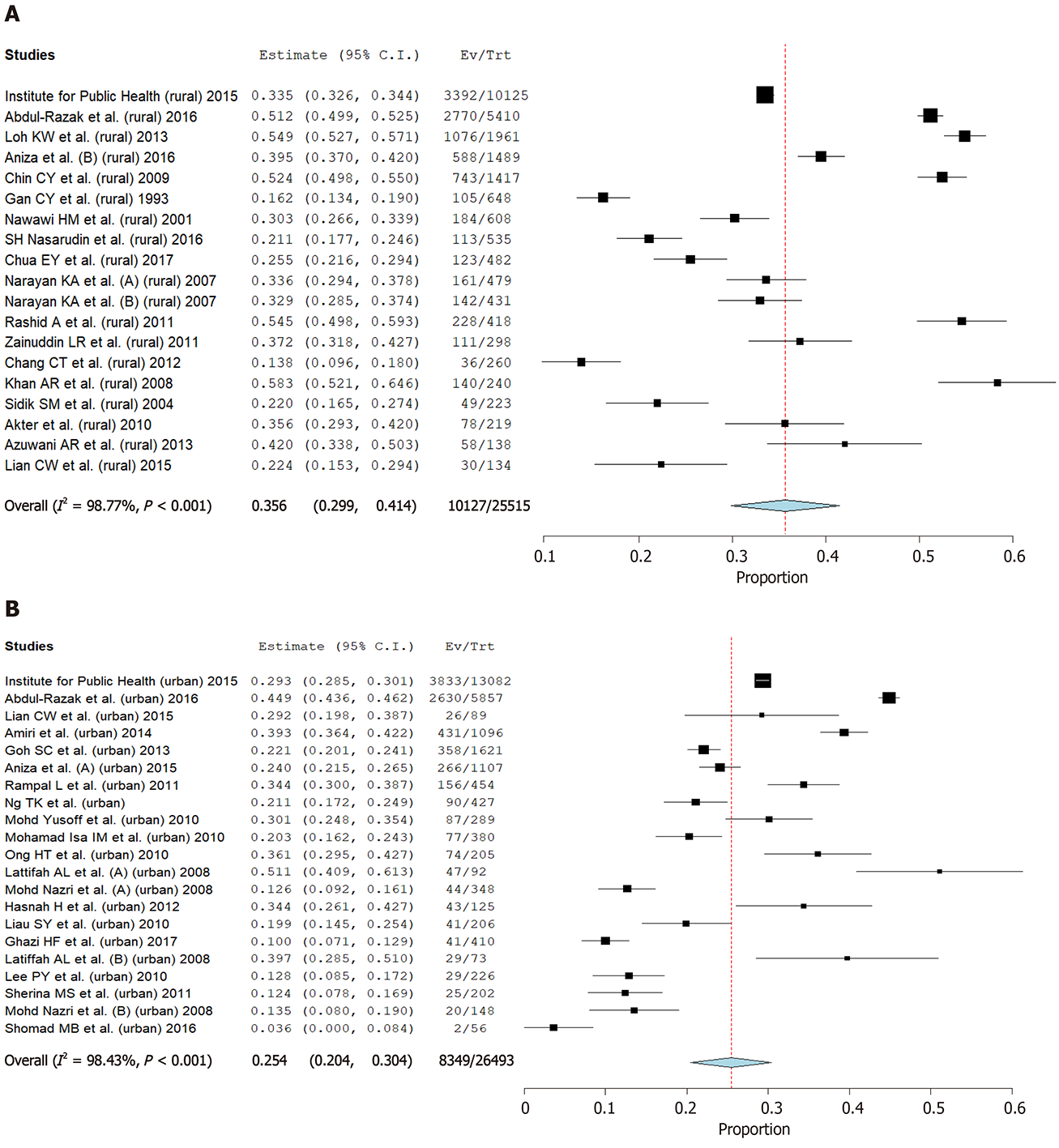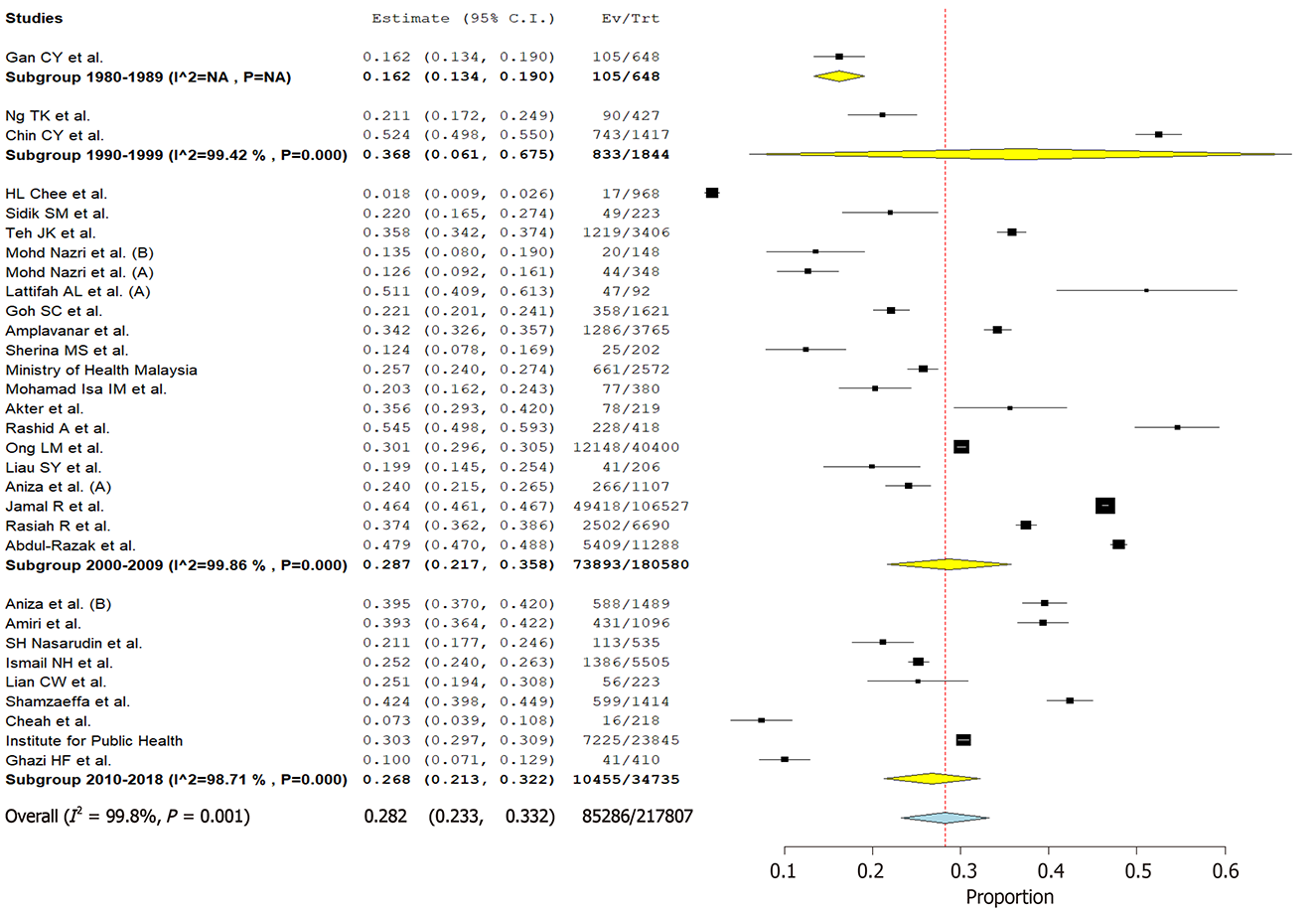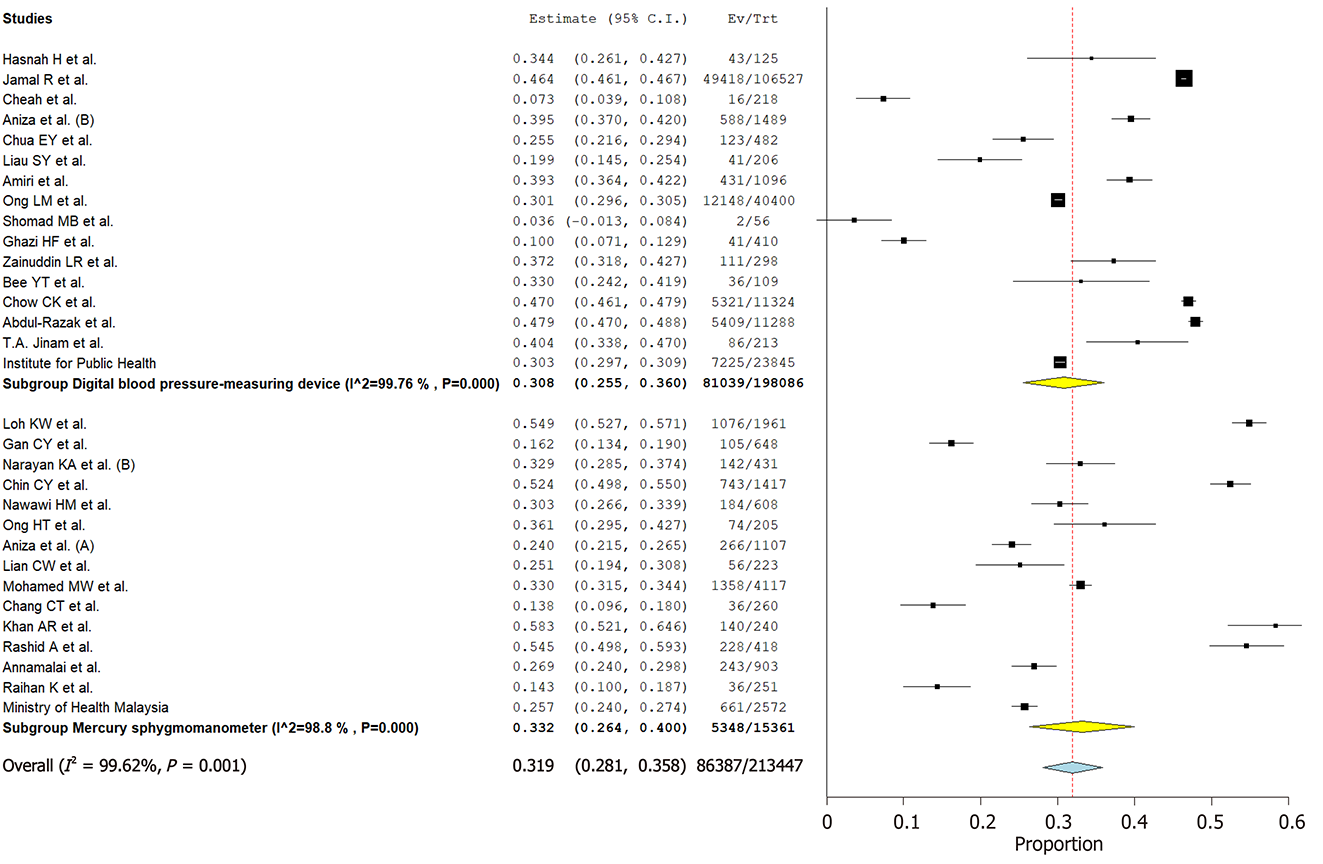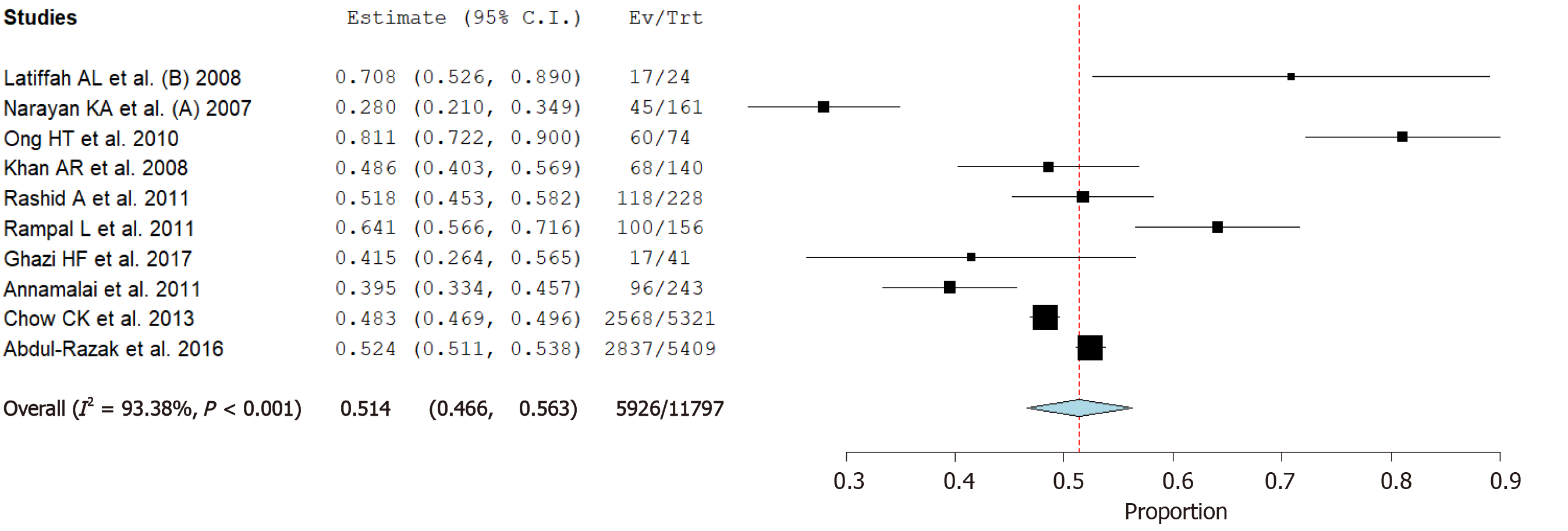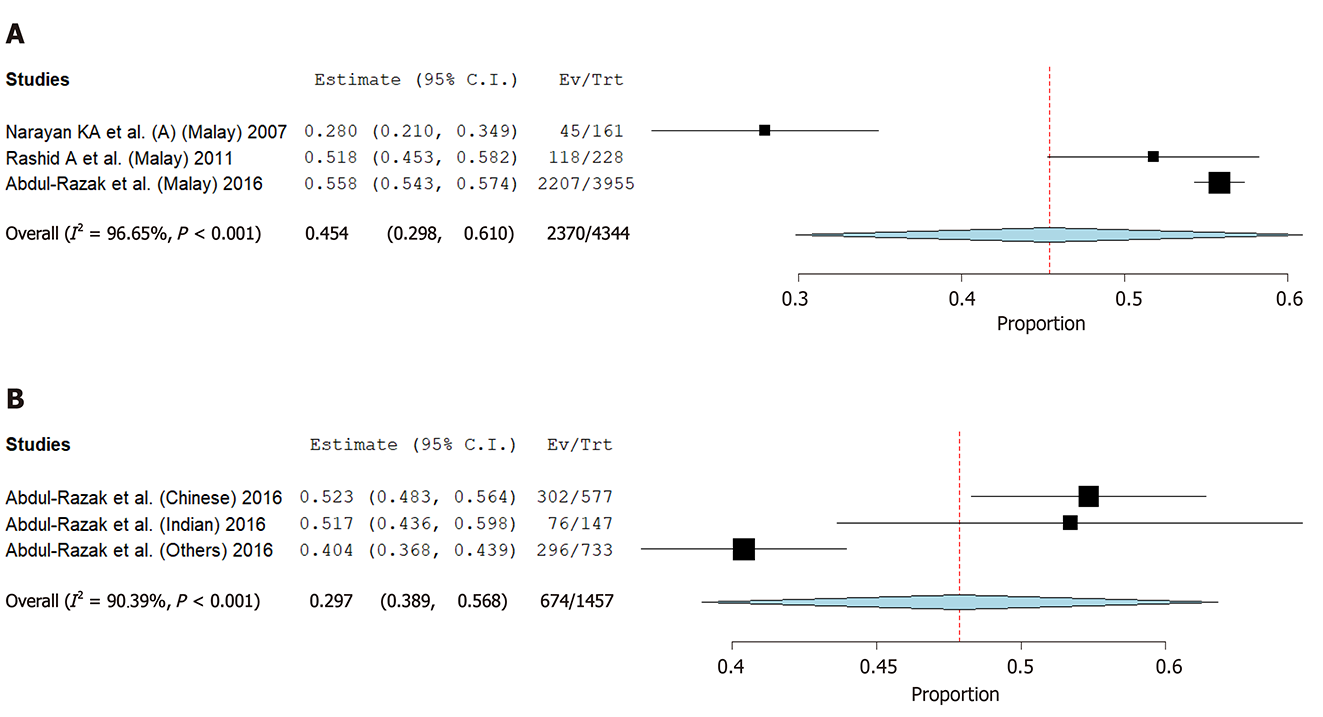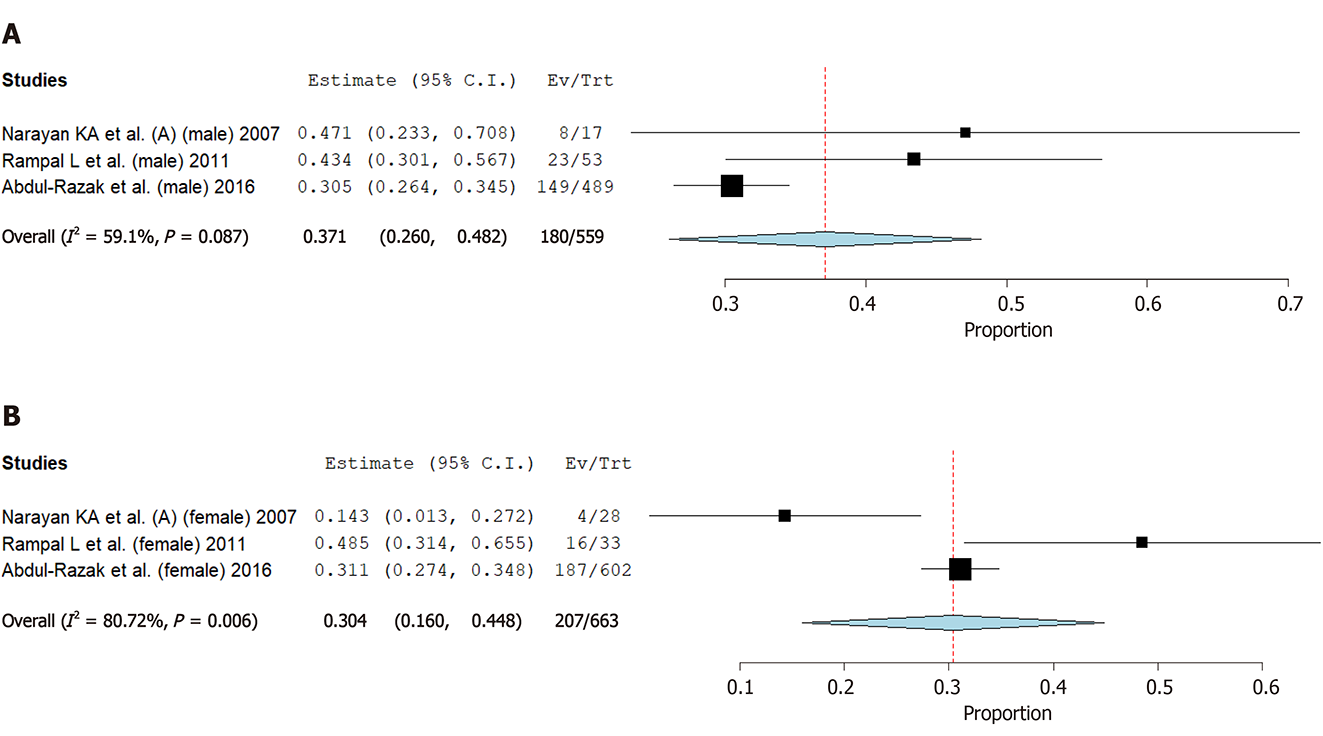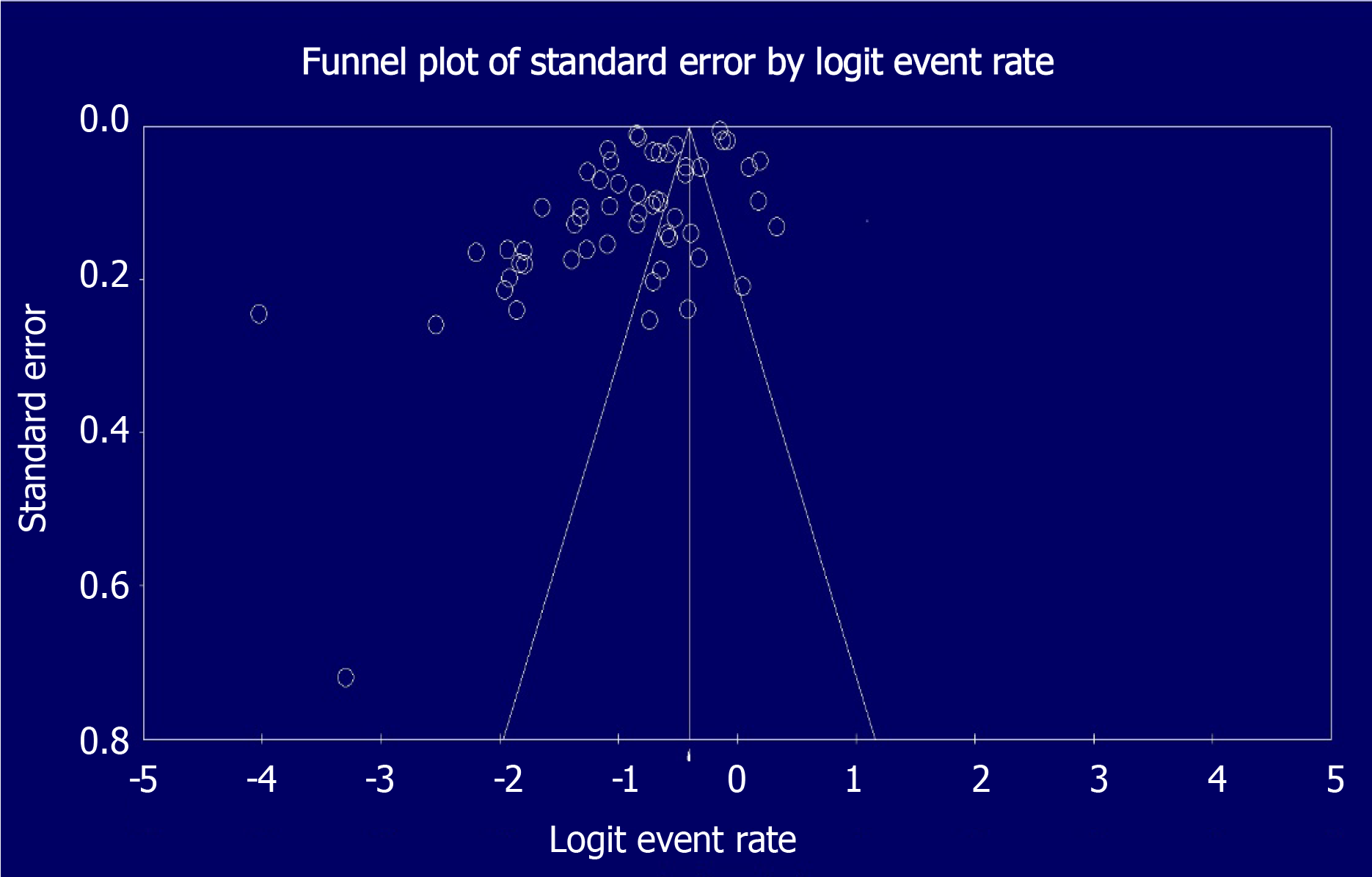Published online Aug 28, 2020. doi: 10.13105/wjma.v8.i4.320
Peer-review started: June 27, 2020
First decision: August 8, 2020
Revised: August 22, 2020
Accepted: August 27, 2020
Article in press: August 27, 2020
Published online: August 28, 2020
Hypertension is a common public health problem worldwide and is a well-known risk factor for increased risk of cardiovascular diseases, contributing to high morbidity and mortality. However, there has been no systematic review and meta-analysis of a multiethnic population such as that of Malaysia.
To determine the trend in prevalence, awareness and control rate of hypertension in Malaysia.
Systematic searches were conducted in six databases (PubMed, Scopus, Ovid, CINAHL, Malaysian Medical Repository and Malaysia Citation Index) for articles published between 1980 and 2018. Two authors reviewed the studies and performed quality assessment and data extraction independently. Pooled estimates of hypertension prevalence, awareness and control rate were calculated using the DerSimonian-Laird random-effects model. Subgroup and sensitivity analyses were performed.
We included 56 studies involving a total of 241796 participants. The overall pooled prevalence of hypertension aged ≥ 18 years was 29.7%. The prevalence of hypertension was the lowest in the 1980s (16.2%, 95% confidence interval (CI): 13.4, 19.0), increasing up to 36.8% (95%CI: 6.1, 67.5) in the 1990s, then decreasing to 28.7% (95%CI: 21.7, 35.8) in the 2000s and 26.8% (95%CI: 21.3, 32.3) in the 2010s. The prevalence of awareness was 51.4% (95%CI: 46.6, 56.3), while 33.3% (95%CI: 28.4, 38.2) of those on treatment had achieved control of their blood pressure.
In Malaysia, three in ten adults aged ≥ 18 years have hypertension, while four in ten adults aged ≥ 30 years have hypertension. Five out of ten people are aware of their hypertension status and only one-third of those under treatment achieved control of their hypertension. Concerted efforts by policymakers and healthcare professionals to improve awareness and control of hypertension should be of high priority.
Core Tip: This is a systematic review and meta-analysis reporting that the pooled prevalence of hypertension in people aged ≥ 18 years in Malaysia was 29.7%. The pooled prevalence of awareness towards hypertension was 51.4 % and blood pressure control rate was 33.3%.
- Citation: Soo MJ, Chow ZY, Ching SM, Tan CH, Lee KW, Devaraj NK, Salim HS, Ramachandran V, Lim PY, Sivaratnam D, Hoo FK, Cheong AT, Chia YC. Prevalence, awareness and control of hypertension in Malaysia from 1980-2018: A systematic review and meta-analysis. World J Meta-Anal 2020; 8(4): 320-344
- URL: https://www.wjgnet.com/2308-3840/full/v8/i4/320.htm
- DOI: https://dx.doi.org/10.13105/wjma.v8.i4.320
Hypertension is a common public health problem over the past several decades[1,2]. It is one of the major risk factors for cardiovascular diseases such as stroke, heart failure and ischemic heart disease[3]. In Malaysia, trend analyses have been conducted based on the National Health and Morbidity Surveys, which are nationwide studies that have been performed every 10 years since 1986. The analyses have also shown the trend of hypertension in different genders and ethnicities[4-7]. Besides the National Health and Morbidity Surveys, several other studies have examined the prevalence, awareness and control of hypertension that differed from that of the National Health and Morbidity Surveys[8,9]. The prevalence in different settings and in different age groups may present a slightly different picture along with their accompanying set of problems.
The present systematic review aimed to determine the pooled prevalence of hypertension, awareness and control of hypertension in Malaysia from 1980 to 2018 based on a nationwide survey and other important studies that reported the prevalence of hypertension in different settings and specific groups. Heterogeneities among cross-sectional studies and the national survey may conceivably cause different rates of prevalence. Hence, there is a need for a systematic review and meta-analysis to estimate the pooled prevalence of hypertension in Malaysia. We are not only reporting the trend of hypertension prevalence in Malaysia from 1980 to 2018 but are also providing some important insights into the awareness and control of hypertension among Malaysians.
The present review was registered with PROSPERO (2018: CRD42018075369) and conducted according to the Preferred Reporting Items for Systematic Reviews and Meta-Analyses guidelines[10].
We searched six databases (PubMed, Ovid, Scopus, CINAHL, Malaysian Medical Repository and Malaysia Citation Index) for the relevant articles and included all relevant citations published before February 28, 2018.
The literature search used the following search terms: (prevalence) and (awareness) and (control) and (hypertension or high blood pressure) and (Malaysia), and a combination of expanded MeSH terms and free-text searches were used for the final search up to February 28, 2018: (Prevalence OR Aware* OR Unaware* OR Undiagnosed OR Control* OR Uncontrol* OR “Achieved target”) AND (Hypertension OR “Blood pressure” OR “Systolic blood pressure” OR “Diastolic blood pressure” OR “Raised blood pressure” OR “High blood pressure”) AND (Malaysia OR Perlis OR Kedah OR Penang OR “Pulau Pinang” OR Perak OR Johor OR Selangor OR Pahang OR Malacca OR Melaka OR Terengganu OR Kelantan OR “Negeri Sembilan” OR Sabah OR Sarawak OR “Wilayah Persekutuan” OR Putrajaya OR “Kuala Lumpur” OR “Labuan”).
Any studies, reports or articles published between January 1, 1980 and February 28, 2018 and fulfilling the following criteria were included in the analysis: (1) Included the general population aged ≥ 18 years; (2) Studied the prevalence of hypertension diagnosed using digital automated or mercury sphygmomanometers; (3) Studied either the prevalence, awareness and control of blood pressure (BP) or hypertension individually or any combination of the three; and (4) In English only. We excluded intervention studies, case studies, pharmacogenetic studies, case series, qualitative data, comments or letters, audits, narrative reviews, conference proceeding, opinion pieces, methodological, editorials, animal studies or any other publications lacking primary data and/or explicit method descriptions. When several publications were derived from the same dataset or cohorts, the article that provided the most updated data was selected. We identified other pertinent studies through reverse–forward citation tracking of relevant articles.
We imported relevant articles identified through the databases into EndNote X5 and removed duplicate publications. Two authors (Chow ZY and Tan CH) screened the titles and abstracts independently to search for eligible articles based on the inclusion criteria. If there were discrepancies on including studies, discussions were held and resolved by the senior authors (Ching SM, Hoo FK, Devaraj NK, Salim HS and Cheong AT) for final consensus before the full text of each relevant article was reviewed.
One author (Ramachandran V) recorded data from the selected studies into the extraction form using Excel, while the second author (Ching SM) verified the accuracy and completeness of the extracted data.
The following characteristics of the selected studies were extracted: First author, year of publication, study setting, study design, location of study, geographical area (rural or urban), BP apparatus, sample size and cases with hypertension. The outcome measures extracted were the prevalence of hypertension in terms of the difference of proportion/percent of hypertension, awareness and control in the total patients examined.
Hypertension was defined as BP ≥ 140/90 mmHg based on guidelines from the Fifth Joint National Committee. Awareness was defined as knowing one’s own hypertension status or having been diagnosed with hypertension previously. Control was defined as achieving a target BP of < 140/90 mmHg[11].
Each article underwent quality assessment by two authors (Soo MJ and Lee KW) using a modified critical appraisal checklist (Supplementary material Appendix 1)[8]. The checklist consisted of 11 items that assessed the components in observational studies. Whenever the information provided was insufficient to assist in the evaluation of a certain item, the two authors agreed to grade that item as “0” indicating absence of the item, “0.5” indicated that the information was incomplete, and “1” indicated that the item was presented clearly. The quality of each article was graded as high if it scored ≥ 7/11, or low if it scored < 7/11[8]. The results of the quality assessment are shown in supplementary material Appendix 2.
The results from the meta-analysis summarized the data narrative and statistically used a tabulated format. Heterogeneity between studies for the pooled estimates was examined using I2 (I2 < 25%, low; I2 = 25%-30%, moderate; I2 > 50%, high), indicating the percent of total discrepancy due to variation in the studies[12].
We used OpenMeta[Analyst] for data analysis (http://www.cebm.brown.edu/openmeta/index.html)[13]. The prevalence estimated from individual studies was pooled using random-effects (DerSimonian-Laird method) meta-analysis and was reported with 95% confidence interval (CI). Subgroup analysis was performed to examine the prevalence, awareness and control of hypertension by age group, sex, ethnicity, study setting, study design, geographical origin and BP tools.
Publication bias was assessed by sensitivity analysis using the leave-one-out analysis. We also performed sensitivity analyses for the prevalence of hypertension by discarding low-quality studies, removing outlier subpopulations (point estimates > ± 3 standard deviations)[14] or removing smaller subpopulations (size < 100) or large sample sizes (size > 5000)[15], where these publication biases are known to have effects on the estimated prevalence. The effect size of interest was the proportion of individuals with hypertension. The secular trend of prevalence was estimated by calculating the point estimates for four separate decades.
We identified 1493 manuscripts in the initial search (Figure 1). After removal of duplicate records (n = 251), 1242 studies were retrieved for further assessment. After careful evaluation of the inclusion/exclusion criteria, 52 studies fulfilled our criteria, and this together with another four studies identified from cross-referencing, a total of 56 studies were included in our meta-analysis.
The main characteristics of the included studies are shown in Table 1[16-71] and supplementary material Appendix 3 in encompassing the prevalence, awareness and control of hypertension of the included studies. A total sample size of 241796 respondents from Malaysia was included in the analysis. Overall, the ethnicity distribution was 56.5% Malay, 24.2% Chinese, 9.7% Indian and 9.5% other ethnicities. Fifty-one studies were conducted in the community setting, four were in a hospital setting and one was in a primary care clinic. Quality assessment using a modified critical appraisal checklist showed that the majority of the studies (52/56) were of good quality with only four having poor quality.
| Ref. | Sample size, n | Prevalence of hypertension, % | Prevalence of awareness, % | Prevalence of control, % | Quality of article |
| Abdul-Razak et al[16], 2016 | 11288 | 47.9 | 52.5 | 15.9 | High |
| Jinam et al[17], 2008 | 213 | 40.4 | NA | NA | High |
| Akter et al[18], 2010 | 219 | 35.6 | NA | NA | High |
| Amiri et al[19], 2014 | 1096 | 39.3 | NA | NA | High |
| Amplavanar et al[20], 2010 | 3765 | 34.2 | NA | NA | High |
| Aniza et al[21], 2015 | 1107 | 24.0 | NA | NA | High |
| Aniza et al[22], 2016 | 1489 | 39.5 | NA | NA | High |
| Annamalai et al[23], 2011 | 903 | 26.9 | 39.5 | 15.7 | High |
| Azuwani et al[24], 2013 | 138 | 42.0 | NA | NA | High |
| Tan et al[25], 2008 | 109 | 33.0 | NA | NA | High |
| Chang et al[26], 2012 | 260 | 13.9 | NA | NA | High |
| Cheah et al[27], 2015 | 218 | 7.3 | NA | NA | High |
| Chee et al[28], 2002 | 968 | 1.8 | NA | NA | High |
| Chin et al[29], 2009 | 1417 | 52.4 | NA | NA | High |
| Chow et al[30], 2013 | 11324 | 47.0 | 48.3 | 12.8 | High |
| Chua et al[31], 2017 | 482 | 25.5 | NA | NA | High |
| Gan et al[32], 1993 | 648 | 16.2 | NA | NA | High |
| Ghazi et al[33], 2017 | 410 | 10.0 | 41.5 | NA | Low |
| Goh et al[34], 2013 | 1621 | 22.1 | NA | NA | High |
| Hasnah et al[35], 2012 | 125 | 34.4 | NA | NA | High |
| Hazmi et al[36], 2015 | 308 | 14.3 | NA | NA | High |
| Ministry of Health Malaysia[37], 2015 | 23845 | 30.3 | NA | NA | High |
| Jamal et al[38], 2015 | 106527 | 46.4 | NA | NA | High |
| Khan et al[39], 2008 | 240 | 58.3 | 48.6 | 51.4 | High |
| Latiffah et al[40], 2008 | 73 | 39.7 | 70.8 | 40.9 | High |
| Latiffah et al[41], 2008 | 92 | 51.1 | NA | NA | High |
| Lee et al[42], 2010 | 226 | 12.8 | NA | NA | Low |
| Lian et al[43], 2015 | 223 | 25.1 | NA | NA | High |
| Liao et al[44], 2010 | 206 | 19.9 | NA | NA | High |
| Lim et al[45], 1991 | 368 | 30.4 | NA | NA | High |
| Loh et al[46], 2013 | 1961 | 54.9 | NA | NA | High |
| Ministry of Health Malaysia[47], 2010 | 2572 | 25.7 | NA | NA | High |
| Mohamed et al[48], 2005 | 4117 | 33.0 | NA | NA | High |
| Nazri et al[49], 2008 | 148 | 13.5 | NA | NA | High |
| Nazri et al[50], 2008 | 348 | 12.6 | NA | NA | High |
| Moy et al[51], 2010 | 380 | 20.3 | NA | NA | High |
| Narayan et al[52], 2007 | 431 | 33.0 | NA | NA | High |
| Narayan et al[53], 2007 | 479 | 33.6 | 28.0 | 27.5 | High |
| Nasarudin et al[54], 2016 | 535 | 21.1 | NA | NA | Low |
| Nawawi et al[55], 2002 | 608 | 30.3 | NA | NA | High |
| Ng et al[56], 1995 | 427 | 21.1 | NA | NA | Low |
| Noor Hassim et al[57], 2016 | 5505 | 25.2 | NA | NA | High |
| Ong et al[58], 2010 | 205 | 36.1 | 81.1 | 33.8 | High |
| Ong et al[59], 2013 | 40400 | 30.1 | NA | NA | High |
| Raihan et al[60], 2013 | 251 | 14.3 | NA | NA | High |
| Rampal et al[61], 2008 | 454 | 34.4 | 64.1 | 25.0 | High |
| Rashid et al[62], 2011 | 418 | 54.6 | 51.8 | NA | High |
| Rasiah et al[63], 2015 | 6690 | 37.4 | NA | NA | High |
| Shahar et al[64], 2011 | 71 | 32.4 | NA | NA | High |
| Samsudin et al[65], 2016 | 1414 | 42.4 | NA | NA | High |
| Sherina et al[66], 2011 | 202 | 12.4 | NA | NA | High |
| Shomad et al[67], 2016 | 56 | 4.00 | NA | NA | High |
| Sidik et al[68], 2004 | 223 | 22.0 | NA | NA | High |
| Teh et al[69], 2014 | 3406 | 35.8 | NA | NA | Low |
| Yusoff et al[70], 2010 | 289 | 30.1 | NA | NA | High |
| Zainuddin et al[71], 201 | 298 | 37.3 | NA | NA | High |
Table 2 shows the prevalence of hypertension in Malaysia is 29.7% (95%CI: 26.1, 33.3) (Figure 2). The prevalence of hypertension for those aged ≥ 30 years was 40.0% (Figure 3). The pooled prevalence of hypertension increased with age as the prevalence was 8.6% in adults aged 18–29 years as compared to 42.8% in adults aged ≥ 60 years (Figure 4).
| Variable | Number of studies, n | Prevalence, % | 95%CI | P value | I2, % | Figure | |
| Overall prevalence | |||||||
| Malaysia | 56 | 29.7 | 26.1, 33.3 | < 0.001 | 99.7 | 2 | |
| 30 and above | 16 | 40.0 | 35.3, 44.8 | < 0.001 | 98.9 | 3 | |
| Mean age, yr | 4 | ||||||
| 18–29 | 4 | 8.6 | 5.30, 11.90 | 0.03 | 66.9 | ||
| 30–39 | 3 | 13.5 | 2.9, 29.9 | < 0.001 | 98.7 | ||
| 40–49 | 17 | 27.9 | 24.9, 30.9 | < 0.001 | 96.5 | ||
| 50–59 | 4 | 39.4 | 29.3, 49.4 | < 0.001 | 99.7 | ||
| 60 and above | 6 | 42.8 | 30.2, 55.3 | < 0.001 | 95.8 | ||
| Gender | |||||||
| Male | 26 | 31.4 | 26.5, 36.2 | < 0.001 | 98.1 | 5A | |
| Female | 26 | 27.8 | 20.7, 34.9 | < 0.001 | 99.5 | 5B | |
| Ethnicity | |||||||
| Malay | 17 | 37.3 | 32.9, 41.7 | < 0.001 | 98.9 | 6A | |
| Chinese | 8 | 36.4 | 31.6, 41.2 | < 0.001 | 96.6 | 6B | |
| Indian | 10 | 34.8 | 31.2, 38.4 | < 0.001 | 81.5 | 6C | |
| Other | 9 | 32.9 | 25.8, 40.0 | < 0.001 | 98.0 | 6D | |
| Study setting | 7 | ||||||
| Community | 51 | 30.2 | 26.4, 34.1 | < 0.001 | 99.7 | ||
| Health care setting | 5 | 24.3 | 16.6, 32.0 | < 0.001 | 97.5 | ||
| Geographical origin | |||||||
| Rural | 19 | 35.6 | 29.9, 41.4 | < 0.001 | 98.77 | 8A | |
| Urban | 21 | 25.4 | 20.4, 30.4 | < 0.001 | 98.43 | 8B | |
| Study decade | 9 | ||||||
| 1980-1989 | 1 | 16.2 | 13.4, 19.0 | NA | NA | ||
| 1990-1999 | 2 | 36.8 | 6.1, 67.5 | < 0.001 | 99.42 | ||
| 2000-2009 | 19 | 28.7 | 21.7, 35.8 | < 0.001 | 99.9 | ||
| 2010-2018 | 9 | 26.8 | 21.3, 32.2 | < 0.001 | 98.7 | ||
| Blood pressure measurement tools | 10 | ||||||
| Mercury sphygmomanometer | 15 | 33.2 | 26.4, 40.0 | < 0.001 | 98.8 | ||
| Digital blood pressure device | 16 | 30.8 | 25.5, 36.0 | < 0.001 | 99.8 | ||
Among adults aged ≥ 18 years, the prevalence of hypertension was higher in men compared to women (31.4%, 95%CI: 26.5, 36.2 vs 27.8%, 95%CI: 20.7, 34.9) (Figure 5A and 5B). The prevalence of hypertension was highest among Malays (37.3%, 95%CI: 32.9, 41.7), followed by Chinese (36.4%, 95%CI: 31.6, 41.2) and Indians (34.8%, 95%CI: 31.2, 38.4) (Figure 6A-D). The prevalence of hypertension was 24.3% in healthcare setting as compared to 30.2% in community setting (Figure 7). The prevalence of hypertension in rural areas was 35.6% as compared to 25.4% in urban areas (Figure 8A and 8B).
The prevalence of hypertension was 16.2% in the first decade (1980–1989), 36.8% in the second decade (1990–1999), 28.7% in the third decade (2000–2009) and 26.8% in the fourth decade (2010–2018) (Figure 9).
The prevalence of hypertension in studies that used mercury sphygmomanometers was 33.2% (95%CI: 26.4, 40.0) as compared to 30.8% (95%CI: 25.5, 36.0) in those studies that used a digital BP device (Figure 10). Sensitivity analysis showed that all studies affected the pooled prevalence of hypertension causing it to vary from 25.6% to 30.2%. Therefore, we did not eliminate any studies from the analysis.
The overall prevalence of awareness towards hypertension in Malaysia was 51.4% (95%CI: 46.6, 56.3) (Table 3 and Figure 11). The prevalence of awareness towards hypertension among male hypertensive patients was 67.8% (Figure 12A), whereas it was 62.7% (Figure 12B) among female hypertensive patients[52,56]. Hypertension awareness among the Malays was 45.4% (Figure 13A), while that among non-Malay was 47.9% (Figure 13B). The prevalence of awareness towards hypertension among hypertensive patients living in rural areas was 45.3% (Figure 14) as compared to 54.1% in urban areas (Table 3).
| Variable | Number of studies, n | Prevalence, % | 95%CI | P value | I2, % | Figure |
| Overall awareness | 10 | 51.4 | 46.6, 56.3 | < 0.001 | 93.4 | 11 |
| Gender | ||||||
| Male | 3 | 67.8 | 42.4, 93.1 | < 0.001 | 97.7 | 12A |
| Female | 3 | 62.7 | 52.8, 72.6 | 0.046 | 67.6 | 12B |
| Ethnicity | ||||||
| Malay | 3 | 45.4 | 29.8, 61.0 | < 0.001 | 96.7 | 13A |
| Non-Malay | 3 | 47.9 | 38.9, 56.8 | < 0.001 | 90.4 | 13B |
| Geographical origin | ||||||
| Rural | 4 | 45.3 | 34.9, 55.8 | < 0.001 | 93.3 | 14 |
| Urban | 1 | 54.1 | 52.2, 56.0 | NA | NA | |
| Overall control | 8 | 33.3 | 28.4, 38.2 | < 0.001 | 85.2 | 15 |
| Gender | ||||||
| Male | 3 | 37.1 | 26.0, 48.2 | < 0.001 | 59.1 | 16A |
| Female | 3 | 30.4 | 16.0, 44.8 | < 0.001 | 80.7 | 16B |
| Ethnicity | ||||||
| Malay | 2 | 29.3 | 27.2, 31.5 | 0.68 | 0 | 17A |
| Non-Malay | 3 | 35.6 | 29.9, 41.3 | 0.210 | 35.9 | 17B |
| Geographical origin | ||||||
| Rural | 3 | 34.1 | 15.5, 52.7 | < 0.001 | 94.7 | 18 |
| Urban | 1 | 36.5 | 33.6, 39.3 | NA | NA | |
The control rate of hypertension was indicated in Table 3. Among the patients who were aware they were hypertensive, 33.3% (95%CI: 28.4, 38.2) achieved control of their BP (Figure 15). Our analysis found that men had slightly better control than women (37.1% vs 30.4%) (Figure 16A and 16B). We also found that 29.3% of Malays had control of their BP (Figure 17A), while that of non-Malays was 35.6% (Figure 17B). Urbanites had higher hypertension control than those living in rural areas (36.5% vs 34.1%) (Figure 18) (Table 3).
Visual inspection of the funnel plot of the result of overall prevalence of hypertension showed an asymmetrical plot, suggesting some degree of publication bias (Figure 19). The main analysis for the prevalence of hypertension was rerun by removing one subpopulation at a time. The pooled estimates did not vary much from the original analysis during each removal. The removal of five low-quality studies or smaller subpopulations (size < 100) also did not affect the original estimate of hypertension rates (Table 4).
| Variable | Number of studies, n | Total sample size, n | Total hypertensive, n | Prevalence, % | 95%CI | P value | I2, % |
| Overall prevalence | 56 | 241796 | 94996 | 29.7 | 26.1, 33.3 | < 0.001 | 99.7 |
| Upon removal of studies with poor quality studies | 51 | 237181 | 93473 | 28.5 | 26.0, 31.2 | < 0.001 | 99.4 |
| Upon removal of studies with nonrandom sampling | 19 | 131904 | 59786 | 29.7 | 26.2, 33.4 | < 0.001 | 98.6 |
| Upon removal of studies with sample size < 100 | 52 | 131904 | 59786 | 28.0 | 25.6, 30.6 | < 0.001 | 99.3 |
| Upon removal of studies with large sample size > 500 | 47 | 28335 | 8943 | 28.4 | 23.3, 33.4 | < 0.001 | 99.2 |
| Upon removal of poor-quality studies, nonrandom studies and studies with sample size < 100 | 12 | 46618 | 16031 | 26.3 | 21.6, 31.6 | < 0.001 | 99.2 |
To the best of our knowledge, this systematic review is the first in Malaysia to describe the prevalence and its trends over four decades for hypertension awareness and control. In addition, due to the fact that Malaysia is a multiethnic country, its variation in the prevalence, awareness and control of hypertension is crucial for us to examine in order to plan our policy in managing hypertension on a nationwide scale.
The overall pooled prevalence of hypertension in Malaysia was 29.7%. The overall prevalence of hypertension in Malaysia was within the range of worldwide hypertension prevalence (20%–50%), as described in a systematic review by Kearney et al[72]. Malaysia has a higher prevalence of hypertension as compared to Thailand (24.7%), Singapore (23.5%) and China (25.2%)[73-75]. A review showed that this prevalence is as high as that in developed countries despite Malaysia being a developing country[76]. In fact, the prevalence of hypertension in Malaysia is higher than that of the United States by 0.7%[77].
We noticed a low prevalence of hypertension in the 1980s. This could be due to only having one study that reported the prevalence of hypertension in the 1980s. Furthermore, that study involved the Kadazan and Bajau ethnic groups, which are minority groups in a rural part of Sabah[32]. Hence, it is not surprising that the prevalence was so low. The possible explanations include the fact that the study was not only limited to a rural population, but it was also the era before urbanization whereby unhealthy lifestyles were not practiced commonly reflected strongly by a low prevalence of diabetes of less than 5% in the years 1980-1985 in South East Asia[78]. Otherwise, we noticed a spike in hypertension prevalence from the 1980s to the 1990s (36.8%). Then, it decreased to 28.7% in the 2000s and further decreased to 26.8% in the 2000s. A possible reason for the increased prevalence in the 1990s could be due to the fact that among the 30 studies that specified their study period, only two studies were conducted in the 1990s. One study, which reported hypertension prevalence of 21.1%, involved three rural communities in Bagan Datoh involving a wide variation of citizens from different age groups[56], whereas the other study involved three semi-rural areas in Kuala Langat where the study respondents were from the older age groups (range, 55–95 years; mean age, 65.4 years)[29]. This significantly increases the overall pooled prevalence of hypertension if we only take these two studies with their extreme ends of prevalence into account. In comparison to the trend of prevalence of hypertension in other countries, United States was one of the countries with a consistent prevalence of hypertension of around 29% according to the United States’ National Health and Nutrition Examination Survey[77].
Epidemiological studies have shown that the prevalence of hypertension increases with age, which is consistent with our review. Importantly, we also found that hypertension prevalence was doubled in those aged 40–49 years (27.9%) from those aged 30–39 years (13.5%). Comparing our results to that of a developed country, we also found a similar doubling phenomenon in hypertension prevalence, but it only happened in the older age group, which was 63.1% in those aged ≥ 60 years, rising from 33.2% from those aged 40–59 years[77]. It is expected that aging is closely related to increased rates of hypertension because of the arterial structure alteration and ongoing calcification that leads to increased arterial stiffness[79]. However, when focusing on the older population aged ≥ 60 years, the prevalence of hypertension in this age group in Malaysia is the lowest among Asian countries such as Singapore (73.9%), Korea (68.7%), India and Bangladesh (65%), Taiwan (60.4%), Thailand (51.5%) and China (48.8%)[80-85]. However, this could be due to the fact that studies in Malaysia have defined the elderly as people aged ≥ 60 years old compared to the other studies above, which defined the elderly as people aged ≥ 65 years[80,81,83,85]. In Malaysia, the prevalence of hypertension was 8.6% among those aged 18–29 years and 13.5% among those aged 30–39 years. The prevalence rates are fairly similar to China (18–29 year age group, 9.6%; 30–39 year age group, 13.1%)[86] but lower compared to India (18–29 year age group, 13%; 30–39 year age group, 23%)[87].
We found that the prevalence of hypertension was higher in men compared to women. This finding is similar to that of the National Health and Nutrition Examination Survey in the United States[88], which reported that regardless of race and ethnicity, men in the 20–40 year age group had higher prevalence of hypertension than women[88]. The sex differences in hypertension are due to both biological and behavioral factors[89]. Biologically, the female sex hormone, estrogen, serves as a protective factor against hypertension and other cardiovascular-related diseases in women[90,91]. Unhealthy lifestyle such as smoking was more prevalent among men compared to women[90-93]. Because smoking is a risk factor for hypertension[94,95], it is not surprising that the prevalence of hypertension is higher in men.
In our review, 51.4% (95%CI: 46.6, 56.3) of the included sample was aware of their hypertension status. This finding is lower than the rates reported in United States (63%)[96], Singapore (69.7%)[80] and Korea (91.7%)[81]. Even though, the awareness of hypertension in Malaysia is higher than that in India (25.1%)[83] and Indonesia (35.8%)[73], this finding is still worrying as it indicates one out of two adults remain undetected or untreated for their hypertension. Therefore, various nationwide blood pressure screening campaign is urgently needed. Indeed May Measurement Month was a good move as it was a nationwide blood pressure screening program that was conducted in conjunction with World Hypertension Day under the tutelage of the International Society of Hypertension[94].
Regarding the higher prevalence of awareness towards hypertension in Malaysia as compared to India[83] and Indonesia[73], the possible explanation could be due to the fact that one of the studies was conducted in a residential home with a higher caregiver to resident ratio and frequent supervision. This explained why the residents’ awareness of hypertension was high[58]. On the other hand, another study involved university staff with high education levels, and therefore the awareness of hypertension will certainly be high[61]. In terms of ethnicity, only one study examined the ethnic differences of hypertension awareness[16], while the two other studies involved only Malay ethnicity as the study population[62] and Malay villagers in rural communities, respectively[70]. Comparison of geographical origin yielded similar results, where only one study examined the difference in awareness[16] while the three other studies all focused on awareness among the rural communities rather than examining the geographical difference of hypertensive awareness[46,52,62]. It will be right to assume that there will be much bias and higher heterogeneity, and therefore pooled analyses were not done for these subgroups.
Hypertension control in Malaysia was 33.3%, which is much lower than that of developed countries such as the United States (53%)[17]. Conversely, it is higher than that of nearby countries such as China (13.8%)[73,84], Hong Kong (25.8%)[95] and the Philippines (27.0%)[97]. This could be due to the fact that Malaysia has been improving its quality of healthcare facilities, building more clinics and hospitals and more of the latest drugs are available in these healthcare facilities[98]. We found that men achieved better BP control than women. This is surprising because the literature reported that women are always more likely to have better health-seeking behavior and expected to have better blood pressure control[99]. Urban dwellers had better BP control, which correlates with a study in Southern China that reported similar results[100]. This may be due to limited access to healthcare facilities in rural areas despite the number of rural clinics increasing throughout the past four decades in Malaysia[98]. It seems likely that a poorer health awareness among those living in rural areas or with lower socioeconomic profiles remains an important barrier to visiting healthcare facilities and thereby receiving proper treatment.
The strength of this review was the large sample size summarizing prevalence of hypertension in Malaysia across four decades. Furthermore, this is interesting to analyze the prevalence of hypertension according to different subgroups especially when Malaysia is known to have different races with corresponding different cultures and lifestyle. The accompanying underlying problems were different from each other, and it has been addressed in this systematic review.
However, there are several limitations. First, we found that many studies did not report data of prevalence, awareness and control of hypertension in subgroups of gender, ethnicity and geographical origin, whereby these factors could further help health care policy makers to configure hypertension screening and awareness campaigns according to these subgroups in regards to hypertension prevalence, poor awareness and lack of control. Secondly, we adopted strict inclusion and exclusion criteria and therefore unpublished data or grey literature were not included in the study. However, based on the sensitivity analysis, prevalence of hypertension after removal of these studies with poor quality, nonrandom sampling and/or extreme sample size were not changed as compared to overall pooled prevalence of hypertension. Thirdly, the estimates for the earlier time periods were based on fewer studies when compared to that for latter periods, which may have caused a paucity of literature on the topic of interest.
Future studies on the prevalence of hypertension can address some of the issues noted in this research. The prevalence of hypertension according to gender, ethnicity and geographical origin should be studied in more detail. Nonrandom sampling method should be avoided because it would lead to bias in the conducted study. Besides that, future studies should also emphasize on adequate or larger sample size, which is more representative of a population.
One-third of Malaysian adults are hypertensive. The prevalence of hypertension is higher in people who reside in rural areas than in those who stay in urban areas. Slightly more than half of the adults are aware of their hypertension status and one-third of these patients achieved target BP control. In view of these findings, urgent steps for improving health promotion and health education need to be undertaken on a larger scale. Although our review shows a decreasing trend of hypertension prevalence throughout the past four decades, hypertension awareness and BP control among Malaysians have yet to improve significantly.
Hypertension is a common public health problem worldwide.
Future studies on the prevalence of hypertension can address some of issues noted in this research. The prevalence of hypertension according to gender, ethnicity and geographical origin should be studied in more detail.
This systematic review aimed to determine the trend in prevalence, awareness and control rate of hypertension in Malaysia.
A systematic search was conducted in six databases for articles published between 1980 and 2018. Authors reviewed the studies and performed quality assessment and data extraction independently.
The overall pooled prevalence of hypertension in Malaysia was 29.7%. The overall prevalence of awareness was 51.4%, and 33.3% of those on treatment had achieved control of their blood pressure.
In Malaysia, three in ten adults aged ≥ 18 years have hypertension, while four in ten adults aged ≥ 30 years have hypertension. Five out of ten people are aware of their hypertension status and only one-third of those under treatment achieved control of their hypertension.
Concerted efforts by policymakers and healthcare professionals to improve awareness and control of hypertension should be of high priority.
Manuscript source: Unsolicited manuscript
Specialty type: Public, environmental and occupational health
Country/Territory of origin: Malaysia
Peer-review report’s scientific quality classification
Grade A (Excellent): 0
Grade B (Very good): 0
Grade C (Good): C, C
Grade D (Fair): D
Grade E (Poor): 0
P-Reviewer: Cheng TH, Tan X, Yang MS S-Editor: Wang JL L-Editor: Filipodia P-Editor: Li JH
| 1. | Sengul S, Akpolat T, Erdem Y, Derici U, Arici M, Sindel S, Karatan O, Turgan C, Hasanoglu E, Caglar S, Erturk S; Turkish Society of Hypertension and Renal Diseases. Changes in hypertension prevalence, awareness, treatment, and control rates in Turkey from 2003 to 2012. J Hypertens. 2016;34:1208-1217. [PubMed] [DOI] [Cited in This Article: ] [Cited by in Crossref: 48] [Cited by in F6Publishing: 50] [Article Influence: 7.1] [Reference Citation Analysis (0)] |
| 2. | Bundy JD, He J. Hypertension and Related Cardiovascular Disease Burden in China. Ann Glob Health. 2016;82:227-233. [PubMed] [DOI] [Cited in This Article: ] [Cited by in Crossref: 87] [Cited by in F6Publishing: 93] [Article Influence: 15.5] [Reference Citation Analysis (0)] |
| 3. | Ogah OS, Okpechi I, Chukwuonye II, Akinyemi JO, Onwubere BJ, Falase AO, Stewart S, Sliwa K. Blood pressure, prevalence of hypertension and hypertension related complications in Nigerian Africans: A review. World J Cardiol. 2012;4:327-340. [PubMed] [DOI] [Cited in This Article: ] [Cited by in Crossref: 111] [Cited by in F6Publishing: 106] [Article Influence: 8.8] [Reference Citation Analysis (0)] |
| 4. | Ministry of Health Malaysia. National Health and Morbidity Survey 2. 1996. [Cited in This Article: ] |
| 5. | Ministry of Health Malaysia. National Health and Morbidity Survey 3. 2006. [Cited in This Article: ] |
| 6. | Ministry of Health Malaysia. National Health and Morbidity Survey 4 (2011-2014). 2014. [Cited in This Article: ] |
| 7. | Ministry of Health Malaysia. National Health and Morbidity Survey 5 (2015-2018). 2018. [Cited in This Article: ] |
| 8. | Rizwan SA, Kumar R, Singh AK, Kusuma YS, Yadav K, Pandav CS. Prevalence of hypertension in Indian tribes: a systematic review and meta-analysis of observational studies. PLoS One. 2014;9:e95896. [PubMed] [DOI] [Cited in This Article: ] [Cited by in Crossref: 32] [Cited by in F6Publishing: 25] [Article Influence: 2.5] [Reference Citation Analysis (0)] |
| 9. | Ministry of Health Malaysia. Summary of NHMS Report on Disease Prevalence: National Prevalence of Noncommunicable Diseases/Risk Factors From NHMS 1996 to 2015. 2017. [Cited in This Article: ] |
| 10. | Moher D, Shamseer L, Clarke M, Ghersi D, Liberati A, Petticrew M, Shekelle P, Stewart LA; PRISMA-P Group. Preferred reporting items for systematic review and meta-analysis protocols (PRISMA-P) 2015 statement. Syst Rev. 2015;4:1. [PubMed] [DOI] [Cited in This Article: ] [Cited by in Crossref: 15040] [Cited by in F6Publishing: 13770] [Article Influence: 1530.0] [Reference Citation Analysis (1)] |
| 11. | Gifford RW. The fifth report of the Joint National Committee on Detection, Evaluation, and Treatment of High Blood Pressure: insights and highlights from the chairman. Cleve Clin J Med. 1993;60:273-277. [PubMed] [DOI] [Cited in This Article: ] [Cited by in Crossref: 5] [Cited by in F6Publishing: 5] [Article Influence: 0.2] [Reference Citation Analysis (0)] |
| 12. | Higgins JP, Thompson SG. Quantifying heterogeneity in a meta-analysis. Stat Med. 2002;21:1539-1558. [PubMed] [DOI] [Cited in This Article: ] [Cited by in Crossref: 21630] [Cited by in F6Publishing: 23012] [Article Influence: 1046.0] [Reference Citation Analysis (0)] |
| 13. | Wallace BC, Dahabreh IJ, Trikalinos TA, Lau J, Trow P, Schmid CH. Closing the gap between methodologists and end-users: R as a computational back-end. J Stat Softw. 2012;49:1-15. [DOI] [Cited in This Article: ] [Cited by in Crossref: 503] [Cited by in F6Publishing: 511] [Article Influence: 42.6] [Reference Citation Analysis (1)] |
| 14. | Ghosh D, Vogt A. Outliers: An evaluation of methodologies. Joint statistical meetings. San Diego: American Statistical Association 2012; 3455–3460. [Cited in This Article: ] |
| 15. | Sagie A, Koslowsky M. Detecting moderators with meta‐analysis: An evaluation and comparison of techniques. Pers Psychol. 1993;46:629-640. [DOI] [Cited in This Article: ] [Cited by in Crossref: 62] [Cited by in F6Publishing: 61] [Article Influence: 2.0] [Reference Citation Analysis (0)] |
| 16. | Abdul-Razak S, Daher AM, Ramli AS, Ariffin F, Mazapuspavina MY, Ambigga KS, Miskan M, Abdul-Hamid H, Mat-Nasir N, Nor-Ashikin MN, Ng KK, Nawawi H, Yusoff K; REDISCOVER Investigators. Prevalence, awareness, treatment, control and socio demographic determinants of hypertension in Malaysian adults. BMC Public Health. 2016;16:351. [PubMed] [DOI] [Cited in This Article: ] [Cited by in Crossref: 43] [Cited by in F6Publishing: 49] [Article Influence: 6.1] [Reference Citation Analysis (0)] |
| 17. | Jinam TA, Phipps ME, Indran M, Kuppusamy UR, Mahmood AA, Hong LC, Edo J. An update of the general health status in the indigenous populations of Malaysia. Ethn Health. 2008;13:277-287. [PubMed] [DOI] [Cited in This Article: ] [Cited by in Crossref: 11] [Cited by in F6Publishing: 10] [Article Influence: 0.6] [Reference Citation Analysis (0)] |
| 18. | Akter SFU, Fauzi ARM, Nordin MS, Satwi S, Mohamed A, Aznan MA, Samsul D. Prevalence of cardiovascular risk factors in a selected community at Kuantan, Pahang, Malaysia. Int J Med Med Sci. 2010;2:322-328. [Cited in This Article: ] |
| 19. | Amiri M, Majid HA, Hairi F, Thangiah N, Bulgiba A, Su TT. Prevalence and determinants of cardiovascular disease risk factors among the residents of urban community housing projects in Malaysia. BMC Public Health. 2014;14 Suppl 3:S3. [PubMed] [DOI] [Cited in This Article: ] [Cited by in Crossref: 21] [Cited by in F6Publishing: 24] [Article Influence: 2.4] [Reference Citation Analysis (0)] |
| 20. | Amplavanar NT, Gurpreet K, Salmiah MS, Odhayakumar N. Prevalence of cardiovascular disease risk factors among attendees of the Batu 9, Cheras Health Centre, Selangor, Malaysia. Med J Malaysia. 2010;65:173-179. [PubMed] [Cited in This Article: ] |
| 21. | Aniza I, Hayati K, Juhaida M, Taufik JA, Badilla II, Khalib L. Obesity related hypertension-gender specific analysis among adults in Tanjung Karang, Selangor, Malaysia. Msian J Public Health Med. 2015;15:41-52. [Cited in This Article: ] |
| 22. | Aniza I, Nurmawati A, Hanizah Y, Ahmad Taufik J. Modifiable risk factors of cardiovascular disease among adults in rural community of Malaysia: a cross sectional study. Msian J Public Health Med. 2016;16:53-61. [Cited in This Article: ] |
| 23. | Annamalai C, Govindaraja C, Chandramouli C. Prevalence, awareness and control of hypertension in estate workers in Malaysia. N Am J Med Sci. 2011;3:540-543. [PubMed] [DOI] [Cited in This Article: ] [Cited by in Crossref: 2] [Cited by in F6Publishing: 3] [Article Influence: 0.3] [Reference Citation Analysis (0)] |
| 24. | Azuwani A, Noor Khairiah K, Cheong YZ, Kok, CC, Aw NSL, Nadiah MS, Abdul Rashid K. Body Fat Percentage Distribution of an Orang Asli Group (Aborigines) in Cameron Highlands, Malaysia. Mal J Nutr. 2013;19:205-214. [Cited in This Article: ] |
| 25. | Tan BY, Kantilal HK, Singh R. Prevalence of metabolic syndrome among Malaysians using the international diabetes federation, national cholesterol education program and modified World Health Organization definitions. Mal J Nutr. 2008;14:65-77. [Cited in This Article: ] |
| 26. | Chang CT, Lee PY, Cheah WL. The prevalence of cardiovascular risk factors in the young and middle-aged rural population in Sarawak, Malaysia. Malays J Med Sci. 2012;19:27-34. [PubMed] [Cited in This Article: ] |
| 27. | Cheah WL, Hazmi H, Chia HQ, Tindin E, Ahmad Zafri NA, Mohd Shah SH. Hypertension and its association with anthropometric indexes among pre-university students. Int J Adolesc Med Health. 2016;28:373-379. [PubMed] [DOI] [Cited in This Article: ] [Cited by in Crossref: 4] [Cited by in F6Publishing: 4] [Article Influence: 0.6] [Reference Citation Analysis (0)] |
| 28. | Chee HL, Rampal KG. Relationship between selected health problems and exposures among women semiconductor workers in Malaysia. Med J Malaysia. 2003;58:387-398. [PubMed] [Cited in This Article: ] |
| 29. | Chin CY, Pengal S. Cardiovascular disease risk in a semirural community in Malaysia. Asia Pac J Public Health. 2009;21:410-420. [PubMed] [DOI] [Cited in This Article: ] [Cited by in Crossref: 22] [Cited by in F6Publishing: 23] [Article Influence: 1.5] [Reference Citation Analysis (0)] |
| 30. | Chow CK, Teo KK, Rangarajan S, Islam S, Gupta R, Avezum A, Bahonar A, Chifamba J, Dagenais G, Diaz R, Kazmi K, Lanas F, Wei L, Lopez-Jaramillo P, Fanghong L, Ismail NH, Puoane T, Rosengren A, Szuba A, Temizhan A, Wielgosz A, Yusuf R, Yusufali A, McKee M, Liu L, Mony P, Yusuf S; PURE (Prospective Urban Rural Epidemiology) Study investigators. Prevalence, awareness, treatment, and control of hypertension in rural and urban communities in high-, middle-, and low-income countries. JAMA. 2013;310:959-968. [PubMed] [DOI] [Cited in This Article: ] [Cited by in Crossref: 1154] [Cited by in F6Publishing: 1184] [Article Influence: 107.6] [Reference Citation Analysis (0)] |
| 31. | Chua EY, Zalilah MS, Haemamalar K, Norhasmah S, Geeta A. Obesity indices predict hypertension among indigenous adults in Krau Wildlife Reserve, Peninsular Malaysia. J Health Popul Nutr. 2017;36:24. [PubMed] [DOI] [Cited in This Article: ] [Cited by in Crossref: 18] [Cited by in F6Publishing: 14] [Article Influence: 2.0] [Reference Citation Analysis (0)] |
| 32. | Gan CY, Chan MK. A blood pressure profile of rural Kadazans and Bajaus in Sabah, east Malaysia. Southeast Asian J Trop Med Public Health. 1993;24:583-589. [PubMed] [Cited in This Article: ] |
| 33. | Ghazi HF, Elnajeh M, AbdalQader M, Baobaid MF, Omar AB. Prevalence of Hypertension and its Association with Nutritional Factors Among University Students in Shah Alam, Malaysia. Pakistan J Nutr. 2017;16:544-549. [DOI] [Cited in This Article: ] [Cited by in Crossref: 2] [Cited by in F6Publishing: 2] [Article Influence: 0.3] [Reference Citation Analysis (0)] |
| 34. | Goh SC, Ho EL, Goh KL. Prevalence and risk factors of non-alcoholic fatty liver disease in a multiracial suburban Asian population in Malaysia. Hepatol Int. 2013;7:548-554. [PubMed] [DOI] [Cited in This Article: ] [Cited by in Crossref: 48] [Cited by in F6Publishing: 47] [Article Influence: 3.9] [Reference Citation Analysis (0)] |
| 35. | Hasnah H, Amin I, Suzana S. Bone health status and lipid profile among post-menopausal malay women in Cheras, Kuala Lumpur. Malays J Nutr. 2012;18:161-171. [PubMed] [Cited in This Article: ] |
| 36. | Hazmi H, Ishak WR, Jalil RA, Hua GS, Hamid NF, Haron R, Shafei MN, Ibrahim MI, Bebakar WM, Ismail SB, Musa KI. Traditional cardiovascular risk-factors among healthcare workers in Kelantan, Malaysia. Southeast Asian J Trop Med Public Health. 2015;46:504-511. [PubMed] [Cited in This Article: ] |
| 37. | Ministry of Health Malaysia. National Health and Morbidity Survey 2015 (NHMS 2015). Vol. II: Non-Communicable Diseases, Risk Factors Other Health Problems. Available from: https://www.researchgate.net/publication/305213149_National_Health_and_Morbidity_Survey_2015-VOLUME_II_Non-Communicable_Diseases_Risk_Factors_Other_Health_Problems. [Cited in This Article: ] |
| 38. | Jamal R, Syed Zakaria SZ, Kamaruddin MA, Abd Jalal N, Ismail N, Mohd Kamil N, Abdullah N, Baharudin N, Hussin NH, Othman H, Mahadi NM; Malaysian Cohort Study Group. Cohort Profile: The Malaysian Cohort (TMC) project: a prospective study of non-communicable diseases in a multi-ethnic population. Int J Epidemiol. 2015;44:423-431. [PubMed] [DOI] [Cited in This Article: ] [Cited by in Crossref: 37] [Cited by in F6Publishing: 43] [Article Influence: 4.3] [Reference Citation Analysis (0)] |
| 39. | Khan AR, Narayan K, Ab Manan AH. The prevalence of hypertension among the elderly in fourteen villages in Kedah, Malaysia. Msian J Med Health Sci. 2008;4:33-39. [Cited in This Article: ] |
| 40. | Latiffah A, Hanachi P. To investigate the relation of hypertension and anthropometric measurement among elderly in Malaysia. J Appl Psychol. 2008;8:3963-3968. [DOI] [Cited in This Article: ] [Cited by in Crossref: 11] [Cited by in F6Publishing: 11] [Article Influence: 0.7] [Reference Citation Analysis (0)] |
| 41. | Latiffah AL, Hanachi P, Khania S. The Association of Hypertension with Major Risks Factors among University Putra Malaysia Retirees. J Med Sci. 2008;8:254-261. [DOI] [Cited in This Article: ] [Cited by in Crossref: 8] [Cited by in F6Publishing: 8] [Article Influence: 0.5] [Reference Citation Analysis (0)] |
| 42. | Lee P, Ong T, Muna S, Syed Alwi S, Kamarudin K. Brief report do university students have high cardiovascular risk? A pilot study from universiti malaysia sarawak (unimas). Malays Fam Physician. 2010;5:41-43. [PubMed] [Cited in This Article: ] |
| 43. | Lian CW, Hazmi H, Thon CC, Muda W. Physical Activity and Cardiovascular Risk Factors Among Malays In Selected Rural and Urban Communities In Sarawak. Msian J Public Health Med. 2015;15:104-111. [Cited in This Article: ] |
| 44. | Liao S, Mohamed Izham M, Hassali M, Shafie A, Nik Mohamed M, Hamdi M. Outcomes of cardiovascular risk factors screening programme among employees of a Malaysian public university. J Clin Diagn Res. 2010;4:2208-2216. [Cited in This Article: ] |
| 45. | Lim TO, Ngah BA. The Mentakab Hypertension Study Project. Part III--Detection of hypertension in the outpatient department. Singapore Med J. 1991;32:338-341. [PubMed] [Cited in This Article: ] |
| 46. | Loh KW, Rani F, Chan TC, Loh HY, Ng CW, Moy FM. The association between risk factors and hypertension in perak, malaysia. Med J Malaysia. 2013;68:291-296. [PubMed] [Cited in This Article: ] |
| 47. | Ministry of Health Malaysia. Malaysia STEPS Noncommunicable Disease Risk Factors Survey 2005-2006. Available from: http://ghdx.healthdata.org/record/malaysia-steps-noncommunicable-disease-risk-factors-survey-2005-2006. [Cited in This Article: ] |
| 48. | Mohamed M, Winn T, Rampal GL, Abdul Rashid A, Mustaffa B. A Prelimenary Result of the Cardiovascular Risk factors Intervention Study (Pikom Study): Diabetes Mellitus, Hypertension and their Associated Factors. Malays J Med Sci. 2005;12:20-25. [PubMed] [Cited in This Article: ] |
| 49. | Nazri SM, Imran MK, Ismail IM, Faris AA. Prevalence of overweight and self-reported chronic diseases among residents in Pulau Kundur, Kelantan, Malaysia. Southeast Asian J Trop Med Public Health. 2008;39:162-167. [PubMed] [Cited in This Article: ] |
| 50. | Nazri SM, Tengku MA, Winn T. The association of shift work and hypertension among male factory workers in Kota Bharu, Kelantan, Malaysia. Southeast Asian J Trop Med Public Health. 2008;39:176-183. [PubMed] [Cited in This Article: ] |
| 51. | Moy FM, Hoe VC, Tan CPL, Rosmawati M. Cardiovascular risks among shift and non-shift workers in a public medical centre in Kuala Lumpur. J Univ Malaya Medical Cent. 2010;13:45-49. [Cited in This Article: ] |
| 52. | Narayan KA, Khan AR. Blood pressure patterns and prevalence of hypertension and its associated factors in a rural community in northern Malaysia. Msian J Public Health Med. 2007;7:14-19. [Cited in This Article: ] |
| 53. | Narayan K, Khan AR. Body mass index and nutritional status of adults in two rural villages in Northern Malaysia. Malays J Nutr. 2007;13:9-17. [Cited in This Article: ] |
| 54. | Nasarudin SH, Ahmad N. Correlation between prehypertension and obesity indices among young adults. Msian J Public Health Med. 2016;16:235-240. [Cited in This Article: ] |
| 55. | Nawawi HM, Nor IM, Noor IM, Karim NA, Arshad F, Khan R, Yusoff K. Current status of coronary risk factors among rural Malays in Malaysia. J Cardiovasc Risk. 2002;9:17-23. [PubMed] [DOI] [Cited in This Article: ] [Cited by in Crossref: 8] [Cited by in F6Publishing: 11] [Article Influence: 0.5] [Reference Citation Analysis (0)] |
| 56. | Ng TK, Tee ES, Rosman A. Rural communities in nutritional transition: emergence of obesity, hypertension and hypercholesterolemia as public health problems in three kampungs in Bagan Datoh, Perak. Malays J Nutr. 1995;1:129-139. [PubMed] [Cited in This Article: ] |
| 57. | Noor Hassim I, Norazman MR, Diana M, Khairul Hazdi Y, Rosnah I. Cardiovascular risk assessment between urban and rural population in Malaysia. Med J Malaysia. 2016;71:331-337. [PubMed] [Cited in This Article: ] |
| 58. | Ong HT, Oung LS, Ong LM, Tan KP. Hypertension in a residential home for the elderly in Penang, Malaysia. Med J Malaysia. 2010;65:18-20. [PubMed] [Cited in This Article: ] |
| 59. | Ong LM, Punithavathi N, Thurairatnam D, Zainal H, Beh ML, Morad Z, Lee SY, Bavanandan S, Kok LS. Prevalence and risk factors for proteinuria: the National Kidney Foundation of Malaysia Lifecheck Health Screening programme. Nephrology (Carlton). 2013;18:569-575. [PubMed] [DOI] [Cited in This Article: ] [Cited by in Crossref: 10] [Cited by in F6Publishing: 11] [Article Influence: 1.1] [Reference Citation Analysis (0)] |
| 60. | Raihan K, Azmawati M. Cigarette smoking and cardiovascular risk factor among male youth population. Msian J Public Health Med. 2013;13:28-36. [Cited in This Article: ] |
| 61. | Rampal L, Rampal S, Azhar MZ, Rahman AR. Prevalence, awareness, treatment and control of hypertension in Malaysia: a national study of 16,440 subjects. Public Health. 2008;122:11-18. [PubMed] [DOI] [Cited in This Article: ] [Cited by in Crossref: 79] [Cited by in F6Publishing: 96] [Article Influence: 5.6] [Reference Citation Analysis (0)] |
| 62. | Rashid A, Azizah A. Prevalence of hypertension among the elderly Malays living in rural Malaysia. Australas Med J. 2011;4:283-290. [PubMed] [DOI] [Cited in This Article: ] [Cited by in Crossref: 10] [Cited by in F6Publishing: 12] [Article Influence: 0.9] [Reference Citation Analysis (0)] |
| 63. | Rasiah R, Thangiah G, Yusoff K, Manikam R, Chandrasekaran SK, Mustafa R, Bakar NB. The impact of physical activity on cumulative cardiovascular disease risk factors among Malaysian adults. BMC Public Health. 2015;15:1242. [PubMed] [DOI] [Cited in This Article: ] [Cited by in Crossref: 7] [Cited by in F6Publishing: 7] [Article Influence: 0.8] [Reference Citation Analysis (0)] |
| 64. | Shahar S, Hassan J, Sundar VV, Kong AY, Ping Chin S, Ahmad SA, Kuan Lee L. Determinants of depression and insomnia among institutionalized elderly people in Malaysia. Asian J Psychiatr. 2011;4:188-195. [PubMed] [DOI] [Cited in This Article: ] [Cited by in Crossref: 15] [Cited by in F6Publishing: 16] [Article Influence: 1.2] [Reference Citation Analysis (0)] |
| 65. | Samsudin S, Abdullah N, Applanaidu SD. The prevalence of diabetes mellitus and hypertension and its effects on healthcare demand among elderly in Malaysia. Int J Public Health Res. 2016;6:741-749. [Cited in This Article: ] |
| 66. | Sherina M, Rampal L, Hejar A, Rozali A, Yunus AM. Prevalence of Urban Poor and Its Health Related Factors in the State of Selangor, Malaysia. Malays J Med Health Sci. 2011;7:17-26. [Cited in This Article: ] |
| 67. | Shomad MBA, Rahman NAA, Rahman NIA, Haque M. The prevalence of cardiovascular disease risk factors among students of international Islamic University Malaysia, Kuantan Campus. J Appl Pharm. 2016;6:051-057. [DOI] [Cited in This Article: ] [Cited by in Crossref: 2] [Cited by in F6Publishing: 2] [Article Influence: 0.3] [Reference Citation Analysis (0)] |
| 68. | Sidik SM, Rampal L, Afifi M. Physical and mental health problems of the elderly in a rural community of sepang, selangor. Malays J Med Sci. 2004;11:52-59. [PubMed] [Cited in This Article: ] |
| 69. | Teh JK, Tey NP, Ng ST. Ethnic and gender differentials in non-communicable diseases and self-rated health in Malaysia. PLoS One. 2014;9:e91328. [PubMed] [DOI] [Cited in This Article: ] [Cited by in Crossref: 25] [Cited by in F6Publishing: 29] [Article Influence: 2.9] [Reference Citation Analysis (0)] |
| 70. | Yusoff MF, Baki MM, Mohamed N, Mohamed AS, Yunus MR, Ami M, Othman I, Ishak AI. Obstructive sleep apnea among express bus drivers in Malaysia: important indicators for screening. Traffic Inj Prev. 2010;11:594-599. [PubMed] [DOI] [Cited in This Article: ] [Cited by in Crossref: 14] [Cited by in F6Publishing: 18] [Article Influence: 1.3] [Reference Citation Analysis (0)] |
| 71. | Zainuddin LR, Isa N, Muda WM, Mohamed HJ. The prevalence of metabolic syndrome according to various definitions and hypertriglyceridemic-waist in malaysian adults. Int J Prev Med. 2011;2:229-237. [PubMed] [Cited in This Article: ] |
| 72. | Kearney PM, Whelton M, Reynolds K, Muntner P, Whelton PK, He J. Global burden of hypertension: analysis of worldwide data. Lancet. 2005;365:217-223. [PubMed] [DOI] [Cited in This Article: ] [Cited by in Crossref: 2858] [Cited by in F6Publishing: 3634] [Article Influence: 191.3] [Reference Citation Analysis (1)] |
| 73. | Chia YC, Buranakitjaroen P, Chen CH, Divinagracia R, Hoshide S, Park S, Shin J, Siddique S, Sison J, Soenarta AA, Sogunuru GP, Tay JC, Turana Y, Wang JG, Wong L, Zhang Y, Kario K; HOPE Asia Network. Current status of home blood pressure monitoring in Asia: Statement from the HOPE Asia Network. J Clin Hypertens (Greenwich). 2017;19:1192-1201. [PubMed] [DOI] [Cited in This Article: ] [Cited by in Crossref: 56] [Cited by in F6Publishing: 58] [Article Influence: 8.3] [Reference Citation Analysis (1)] |
| 74. | Ministry of Health Singapore. National Health Survey. 2010. [Cited in This Article: ] |
| 75. | Wang HH, Wang JJ, Wong SY, Wong MC, Li FJ, Wang PX, Zhou ZH, Zhu CY, Griffiths SM, Mercer SW. Epidemiology of multimorbidity in China and implications for the healthcare system: cross-sectional survey among 162,464 community household residents in southern China. BMC Med. 2014;12:188. [PubMed] [DOI] [Cited in This Article: ] [Cited by in Crossref: 169] [Cited by in F6Publishing: 185] [Article Influence: 18.5] [Reference Citation Analysis (0)] |
| 76. | Pereira M, Lunet N, Azevedo A, Barros H. Differences in prevalence, awareness, treatment and control of hypertension between developing and developed countries. J Hypertens. 2009;27:963-975. [PubMed] [DOI] [Cited in This Article: ] [Cited by in Crossref: 360] [Cited by in F6Publishing: 368] [Article Influence: 24.5] [Reference Citation Analysis (0)] |
| 77. | Fryar CD, Ostchega Y, Hales CM, Zhang G, Kruszon-Moran D. Hypertension Prevalence and Control Among Adults: United States, 2015-2016. NCHS Data Brief. 2017;1-8. [PubMed] [Cited in This Article: ] |
| 78. | NCD Risk Factor Collaboration (NCD-RisC). Worldwide trends in diabetes since 1980: a pooled analysis of 751 population-based studies with 4.4 million participants. Lancet. 2016;387:1513-1530. [PubMed] [DOI] [Cited in This Article: ] [Cited by in Crossref: 2146] [Cited by in F6Publishing: 2290] [Article Influence: 286.3] [Reference Citation Analysis (0)] |
| 79. | McInnes GT. Integrated approaches to management of hypertension: promoting treatment acceptance. Am Heart J. 1999;138:252-255. [PubMed] [DOI] [Cited in This Article: ] [Cited by in Crossref: 48] [Cited by in F6Publishing: 49] [Article Influence: 2.0] [Reference Citation Analysis (0)] |
| 80. | Pinto E. Blood pressure and ageing. Postgrad Med J. 2007;83:109-114. [PubMed] [DOI] [Cited in This Article: ] [Cited by in Crossref: 234] [Cited by in F6Publishing: 265] [Article Influence: 15.6] [Reference Citation Analysis (0)] |
| 81. | Malhotra R, Chan A, Malhotra C, Østbye T. Prevalence, awareness, treatment and control of hypertension in the elderly population of Singapore. Hypertens Res. 2010;33:1223-1231. [PubMed] [DOI] [Cited in This Article: ] [Cited by in Crossref: 57] [Cited by in F6Publishing: 60] [Article Influence: 4.3] [Reference Citation Analysis (0)] |
| 82. | Kim KI, Chang HJ, Cho YS, Youn TJ, Chung WY, Chae IH, Choi DJ, Kim CH. Current status and characteristics of hypertension control in community resident elderly Korean people: data from a Korean longitudinal study on health and aging (KLoSHa study). Hypertens Res. 2008;31:97-105. [PubMed] [DOI] [Cited in This Article: ] [Cited by in Crossref: 30] [Cited by in F6Publishing: 30] [Article Influence: 1.9] [Reference Citation Analysis (0)] |
| 83. | Hypertension Study Group. Prevalence, awareness, treatment and control of hypertension among the elderly in Bangladesh and India: a multicentre study. Bull World Health Organ. 2001;79:490-500. [PubMed] [Cited in This Article: ] |
| 84. | Lu FH, Tang SJ, Wu JS, Yang YC, Chang CJ. Hypertension in elderly persons: its prevalence and associated cardiovascular risk factors in Tainan City, southern Taiwan. J Gerontol A Biol Sci Med Sci. 2000;55:M463-M468. [PubMed] [DOI] [Cited in This Article: ] [Cited by in Crossref: 29] [Cited by in F6Publishing: 31] [Article Influence: 1.3] [Reference Citation Analysis (0)] |
| 85. | Chen WW, Gao RL, Liu LS, Zhu ML, Wang W, Wang YJ, Wu ZS, Li HJ, Gu DF, Yang YJ, Zheng Z, Jiang LX, Hu SS. China cardiovascular diseases report 2015: a summary. J Geriatr Cardiol. 2017;14:1-10. [PubMed] [DOI] [Cited in This Article: ] [Cited by in F6Publishing: 137] [Reference Citation Analysis (1)] |
| 86. | Gu D, Reynolds K, Wu X, Chen J, Duan X, Muntner P, Huang G, Reynolds RF, Su S, Whelton PK, He J; InterASIA Collaborative Group. The International Collaborative Study of Cardiovascular Disease in ASIA. Prevalence, awareness, treatment, and control of hypertension in china. Hypertension. 2002;40:920-927. [PubMed] [DOI] [Cited in This Article: ] [Cited by in Crossref: 414] [Cited by in F6Publishing: 436] [Article Influence: 19.8] [Reference Citation Analysis (0)] |
| 87. | Liu X, Xiang Z, Shi X, Schenck H, Yi X, Ni R, Liu C. The Risk Factors of High Blood Pressure among Young Adults in the Tujia-Nationality Settlement of China. Biomed Res Int. 2017;2017:8315603. [PubMed] [DOI] [Cited in This Article: ] [Cited by in Crossref: 6] [Cited by in F6Publishing: 6] [Article Influence: 0.9] [Reference Citation Analysis (0)] |
| 88. | Zafar K, Ram V, Kumar M, Gupta M, Kumar S, Verma V. The prevalence of hypertension among young adults in a rural population of North India. Int J Res Med Sci. 2017;5:4869-4872. [DOI] [Cited in This Article: ] [Cited by in Crossref: 7] [Cited by in F6Publishing: 8] [Article Influence: 1.1] [Reference Citation Analysis (0)] |
| 89. | Cutler JA, Sorlie PD, Wolz M, Thom T, Fields LE, Roccella EJ. Trends in hypertension prevalence, awareness, treatment, and control rates in United States adults between 1988-1994 and 1999-2004. Hypertension. 2008;52:818-827. [PubMed] [DOI] [Cited in This Article: ] [Cited by in Crossref: 622] [Cited by in F6Publishing: 620] [Article Influence: 38.8] [Reference Citation Analysis (0)] |
| 90. | Everett B, Zajacova A. Gender differences in hypertension and hypertension awareness among young adults. Biodemography Soc Biol. 2015;61:1-17. [PubMed] [DOI] [Cited in This Article: ] [Cited by in Crossref: 151] [Cited by in F6Publishing: 146] [Article Influence: 16.2] [Reference Citation Analysis (0)] |
| 91. | Vitale C, Mendelsohn ME, Rosano GM. Gender differences in the cardiovascular effect of sex hormones. Nat Rev Cardiol. 2009;6:532-542. [PubMed] [DOI] [Cited in This Article: ] [Cited by in Crossref: 218] [Cited by in F6Publishing: 231] [Article Influence: 15.4] [Reference Citation Analysis (0)] |
| 92. | Reckelhoff JF. Gender differences in the regulation of blood pressure. Hypertension. 2001;37:1199-1208. [PubMed] [DOI] [Cited in This Article: ] [Cited by in Crossref: 736] [Cited by in F6Publishing: 774] [Article Influence: 33.7] [Reference Citation Analysis (0)] |
| 93. | Naing C, Yeoh PN, Wai VN, Win NN, Kuan LP, Aung K. Hypertension in Malaysia: An Analysis of Trends From the National Surveys 1996 to 2011. Medicine (Baltimore). 2016;95:e2417. [PubMed] [DOI] [Cited in This Article: ] [Cited by in Crossref: 26] [Cited by in F6Publishing: 26] [Article Influence: 3.3] [Reference Citation Analysis (0)] |
| 94. | Chia YC, Ching SM, Chew BN, Devaraj NK, Siti Suhaila MY, Tay CL, Kang PS, Verna Lee KM, Kong SZ, Teoh SW, Nurjasmine AJ, Poulter NR, Beaney T, Xia X. May Measurement Month 2017 blood pressure screening: findings from Malaysia-South-East Asia and Australasia. Eur Heart J Suppl. 2019;21:D77-D79. [PubMed] [DOI] [Cited in This Article: ] [Cited by in Crossref: 19] [Cited by in F6Publishing: 21] [Article Influence: 4.2] [Reference Citation Analysis (0)] |
| 95. | Leung GM, Ni MY, Wong PT, Lee PH, Chan BH, Stewart SM, Schooling CM, Johnston JM, Lam WW, Chan SS, McDowell I, Lam TH, Pang H, Fielding R. Cohort Profile: FAMILY Cohort. Int J Epidemiol. 2017;46:e1. [PubMed] [DOI] [Cited in This Article: ] [Cited by in Crossref: 35] [Cited by in F6Publishing: 39] [Article Influence: 6.5] [Reference Citation Analysis (0)] |
| 96. | Shahbabu B, Dasgupta A, Sarkar K, Sahoo SK. Which is More Accurate in Measuring the Blood Pressure? A Digital or an Aneroid Sphygmomanometer. J Clin Diagn Res. 2016;10:LC11-LC14. [PubMed] [DOI] [Cited in This Article: ] [Cited by in Crossref: 16] [Cited by in F6Publishing: 20] [Article Influence: 2.5] [Reference Citation Analysis (0)] |
| 97. | Sison JA. Philippine Heart Association––Council on Hypertension Report on Survey of Hypertension (PRESYON 3). A report on prevalence of hypertension, awareness and treatment profile. Phil J Cardiol. 2013;41:43-48. [Cited in This Article: ] |
| 98. | Thomas S, Beh L, Nordin RB. Health care delivery in Malaysia: changes, challenges and champions. J Public Health Afr. 2011;2:e23. [PubMed] [DOI] [Cited in This Article: ] [Cited by in Crossref: 34] [Cited by in F6Publishing: 37] [Article Influence: 2.8] [Reference Citation Analysis (0)] |
| 99. | Jaafar NI, Ainin S, Yeong MW. Why bother about health? A study on the factors that influence health information seeking behaviour among Malaysian healthcare consumers. Int J Med Inform. 2017;104:38-44. [PubMed] [DOI] [Cited in This Article: ] [Cited by in Crossref: 12] [Cited by in F6Publishing: 13] [Article Influence: 1.9] [Reference Citation Analysis (0)] |
| 100. | Ma WJ, Tang JL, Zhang YH, Xu YJ, Lin JY, Li JS, Lao XQ, Tam WW, Wong MC, Yu IT. Hypertension prevalence, awareness, treatment, control, and associated factors in adults in southern China. Am J Hypertens. 2012;25:590-596. [PubMed] [DOI] [Cited in This Article: ] [Cited by in Crossref: 64] [Cited by in F6Publishing: 65] [Article Influence: 5.4] [Reference Citation Analysis (0)] |









